|
Mack
Manufacturing Corporation During World War Two
1905-1987-
Allentown, PA
1919-1962 - New Brunswick, NJ
1911-1961 - Plainfield, NJ
This page updated 12-13-2024.
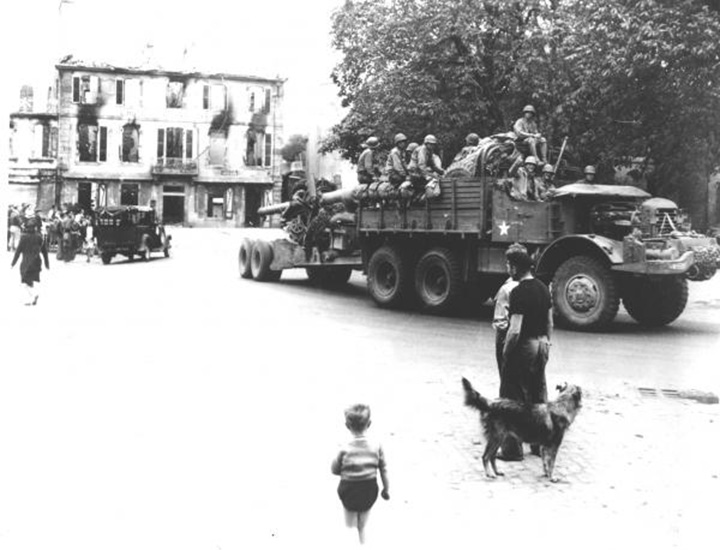
The U.S. Army and this Mack Model NO
7-1/2-ton 6x6 truck is on the roll through Brest, France in August 1944. The truck is being used as a prime mover to pull a 155mm Long Tom
artillery piece. Note that the truck is heavily loaded in the
rear. Photo courtesy of the Mack Truck Historical Museum.
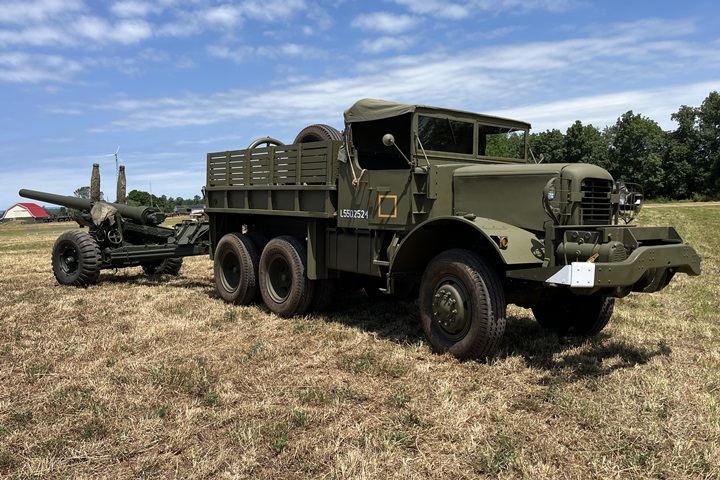
Eighty years after the above photo, truck
historian and collector Jeff Lakaszcyck photographed John Gott's
excellently restored Mack NO-7 in a similar pose. Image added
12-13-2024.
Have you ever heard or used the expression
"It was like getting hit with a Mack truck?" That is because Mack
has a reputation for building big trucks like the Mack model NO
7-1/2-ton trucks as shown above. Table 2 below shows that
the company produced over 29,000 trucks greater than 5-tons during World
War Two.
The company was originally formed in 1900 as
the Mack Brothers Company by Jack and Gus Mack in Brooklyn, NY to
produce motor vehicles. In 1907 the company got into the truck
business with the purchase of
Fallesen and Berry carriage company. Two years earlier the company
had moved to Allentown, PA and has been in that part of Pennsylvania
ever since. The company is currently owned by Volvo resulting in
the Mack headquarters operation moving to Greensboro, SC in 2009.
The company still produces trucks in the Lehigh Valley, PA area not far
from Allentown and is the fourth largest employer in the area. It
is currently known as Mack Trucks.
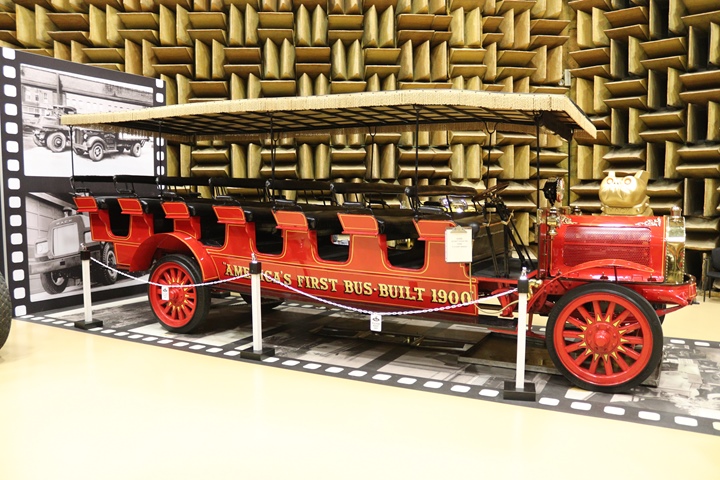
This is considered to be the oldest Mack
vehicle still in existence. While the lettering indicates it was
built in 1900, the registration on the firewall shows it as a 1901.
Author's photo added 7-7-2020.
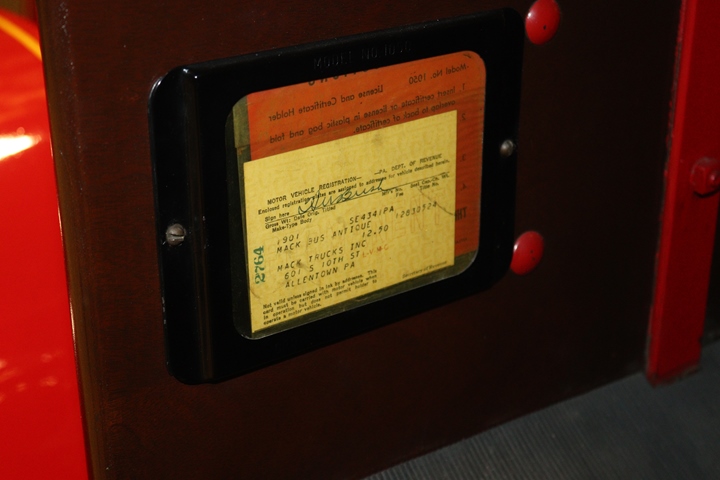
Author's photo added 7-7-2020.
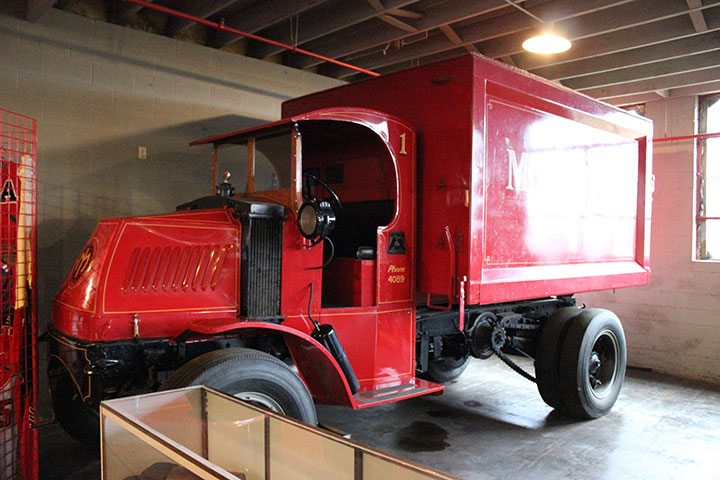
This 1925 Model AC "Bulldog" truck is
similar to what the company provided to the British and US Armies during
World War One. British troops nick named them "Bulldogs" because of their
toughness. Note that the radiator is located just forward of the
firewall and the cooling fan was driven by the flywheel.
Originally the Model AC was introduced in 1916 with hard rubber tires. Author's photo from the National Automotive and Truck
Museum in Auburn, IN.
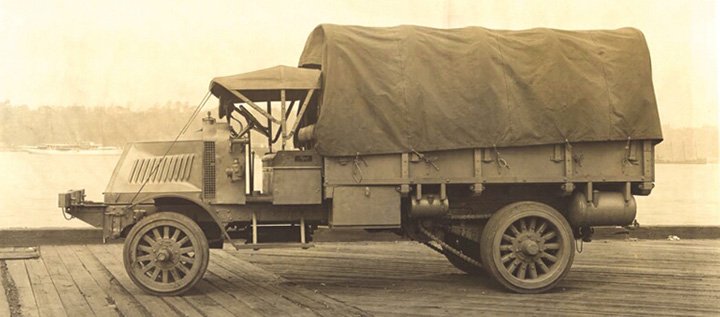
This photo from the Mack Truck Historical
Museum shows a World War One Model AC. The radiator was not placed
in the front grill to prevent damage by stones on the road
or irate teamsters who still used horses and threw rocks at
the trucks.
Mack Manufacturing
Company Army-Navy "E" Award:

Mack Truck in Allentown was awarded the Army-Navy "E"
Award four times. The first award was presented on November 21,
1942, as shown below.
The Mack plant in New Brunswick, NJ was awarded the Army-Navy "E" Award
three times.
The Mack plant in Plainfield, NJ was awarded the Army-Navy "E" Award
three times.
Below is a copy of the pamphlet given to each of the employees at the
Allentown, PA plant at the ceremony for the awarding of the "E" flag.
Photos courtesy of the Mack Truck Historical Museum.
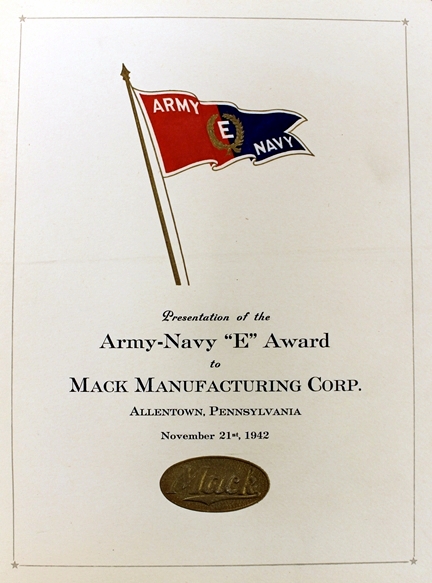
Image added 12-13-2024.
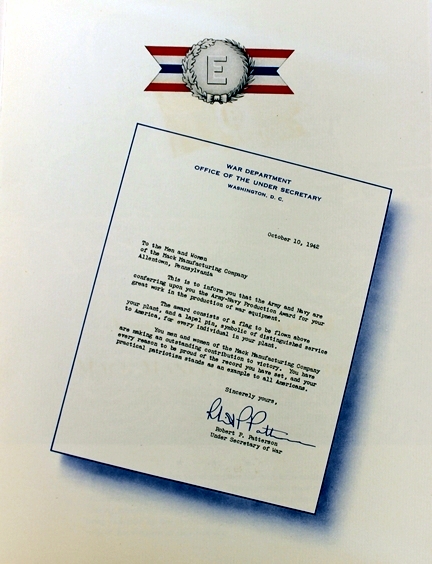
Image added 12-13-2024.
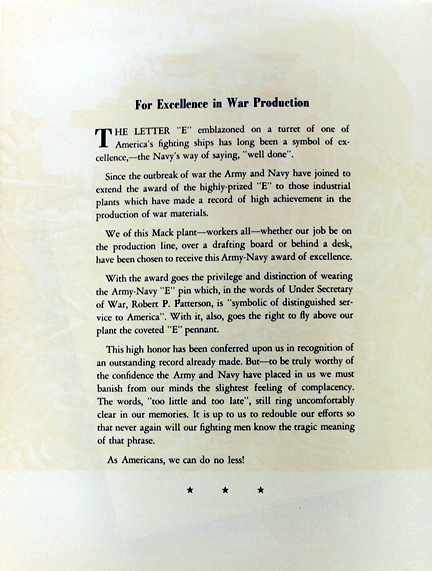
Image added 12-13-2024.
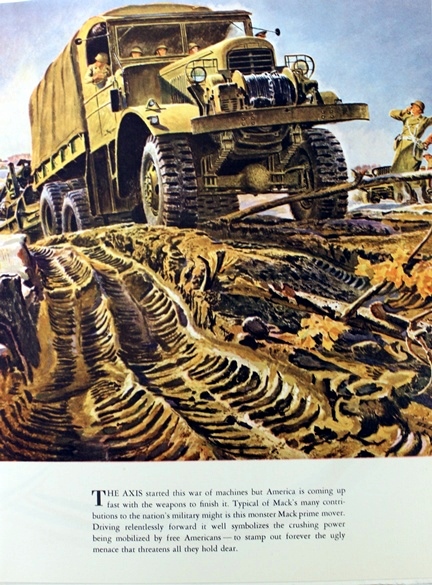
Image added 12-13-2024.
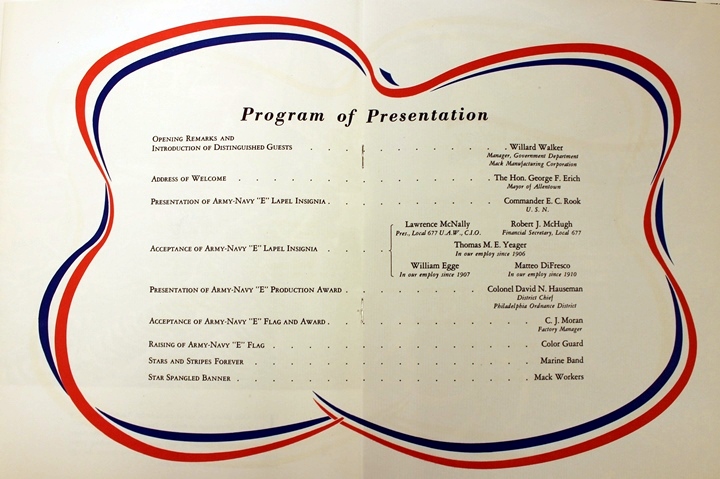
Image added 12-13-2024.
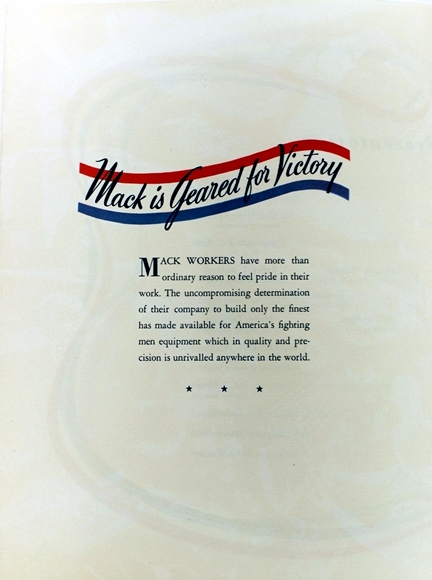
Image added 12-13-2024.
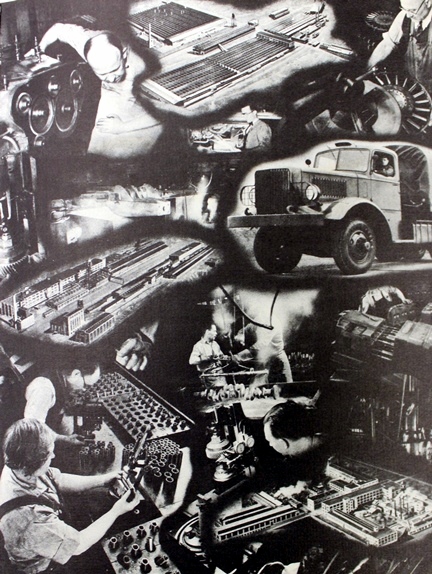
Image added 12-13-2024.
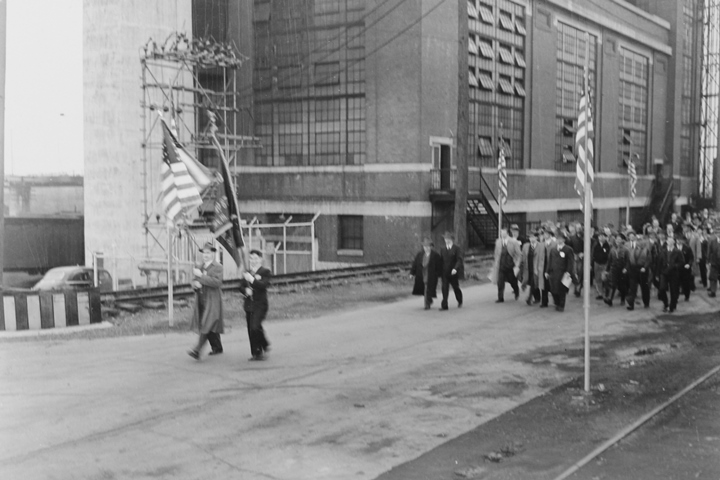
The awarding of the "E" flag was a big deal
for a company during World War Two. There was a ceremony where all
of the employees gathered for the presentation of the flag to company
officials. This and the next photo show the employees marching to
the Allentown final assembly plant for the presentation. Photos
courtesy of the Mack Truck Historical Museum. Image added
12-13-2024.
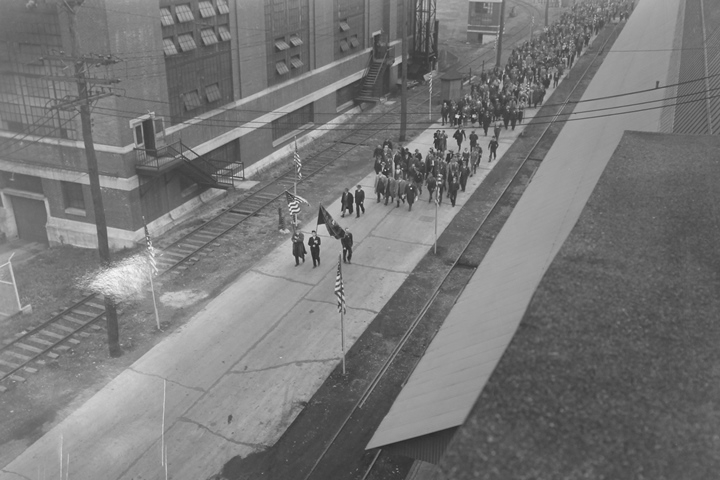
Image added 12-13-2024.
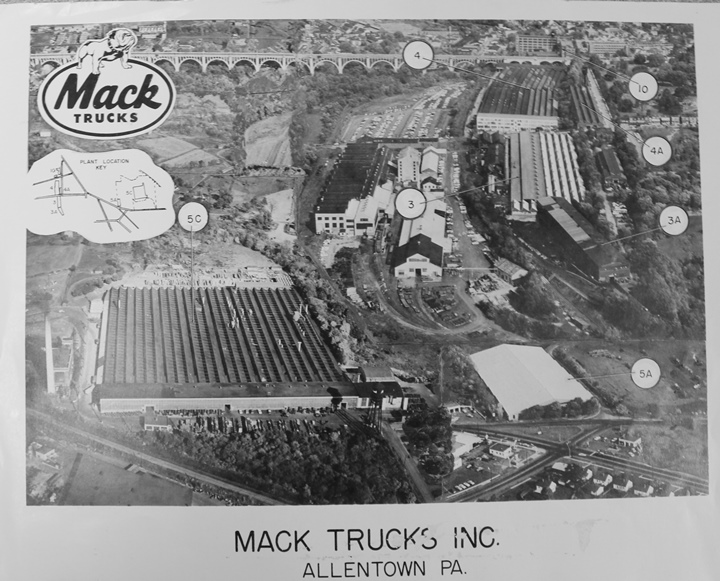
The final assembly plant is in the lower
left hand corner of the photo. The employees shown in the above
photos were from the other plants at the Allentown complex. Photo
courtesy of the Mack Truck Historical Museum. Image added
12-13-2024.
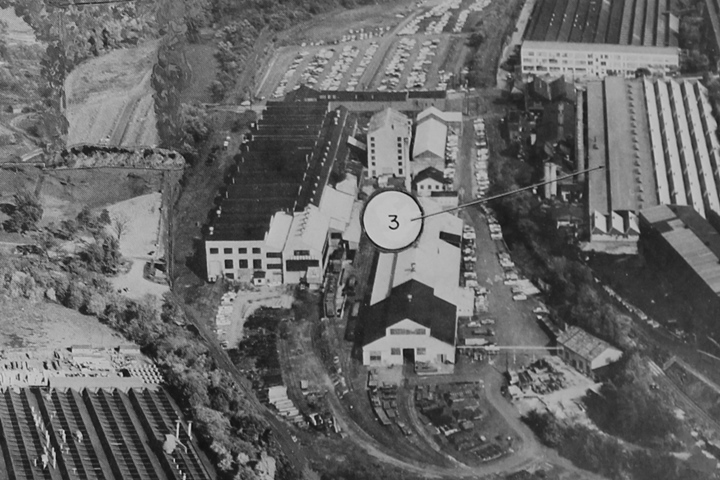
The above photos were taken at the location
of the circled "3." Photo courtesy of the Mack Truck Historical
Museum. Image added 12-13-2024.
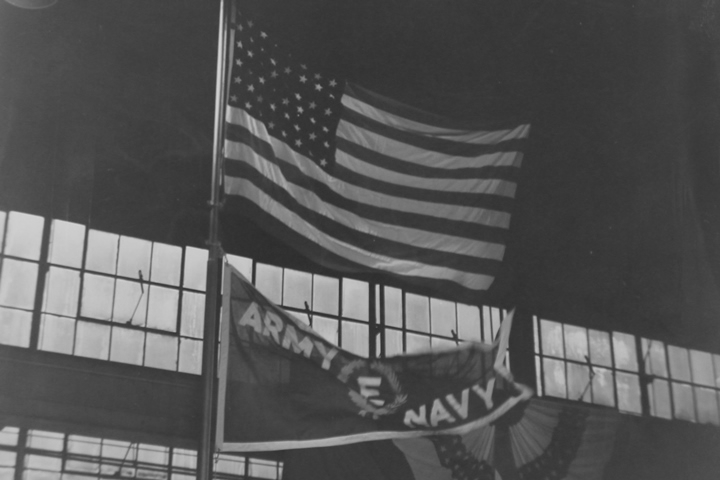
Photo courtesy of the Mack Truck Historical
Museum. Image added 12-13-2024.
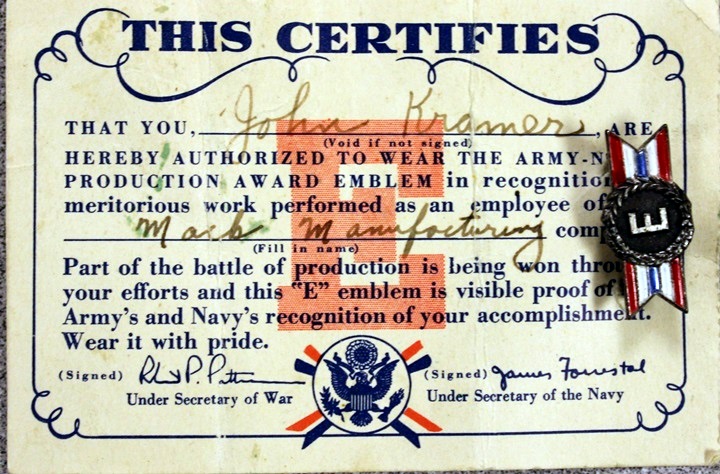
Each employee received a card with an "R"
emblem. Photo courtesy of the Mack Truck Historical Museum.
Image added 12-13-2024.

Three of the World War Two Mack
Manufacturing Corporation-built World War Two Trucks are shown in this
photo. From left to right they are the NM 6-ton 6x6, the EH-2
5-ton 4x2 truck, and the NR 10-ton 6x4 truck. Note the "E" flag in
the background. It has at least one star added to the original
flag. Photo courtesy of the Mack Truck Historical Museum.
Image added 12-13-2024.
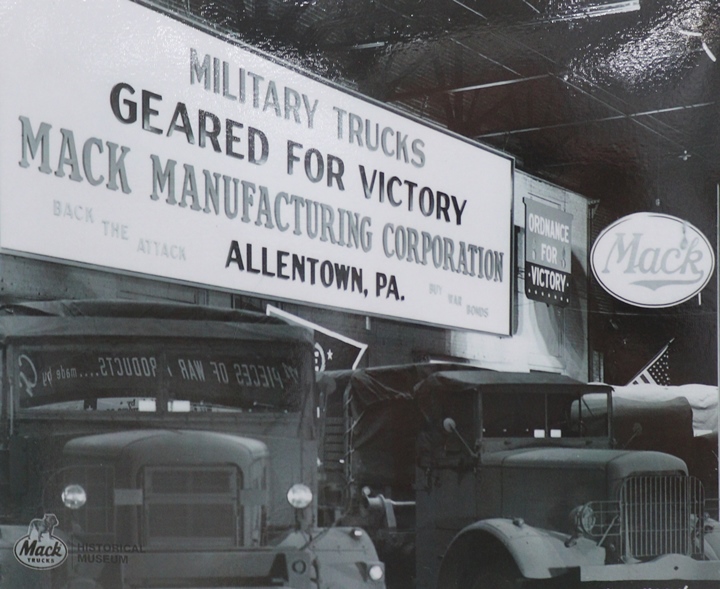
Here is another view of the indoor truck display. Photo courtesy
of the Mack Truck Historical Museum. Image added 12-13-2024.
Mack
Manufacturing Company World War Two Products:
Table 1 shows that the company had
$398,531,000 in major contracts among its four plants. The Allentown plant had the largest
dollar value of contracts totaling $323,796,000 or 84.1% of the
contracts among the four locations. Mack Truck ranked 63rd in
dollar value of all World War Two production contracts.
Table 2 shows that the U.S.
Army Ordnance accepted 29,785 trucks. Table 3 shows that Mack also
produced 320 semi-trailers for U.S. Army Ordnance. The company
also produced 8,131 commercial vehicles to include buses, trucks,
fire truck and trailers, and 2,600 M3 tank power trains.
|
Table 1 -
Summary of Mack Manufacturing Corporation's
Major World War Two Contracts
The information below
comes from the "Alphabetical Listing of Major War Supply
Contracts, June 1940 through September 1945." This was
published by the Civilian Production Administration,
Industrial Statistics Division, Requirements and Progress
Branch January 21, 1946. |
|
Plant Location |
Major Contract Amount |
Percentage |
Products |
Customers |
|
Allentown, PA |
$323,796,000 |
84.1% |
Trucks, Fire Pumpers, Tractor Trucks, Prime Movers, Dump
Trucks, Semi Trailers, Cargo Trucks, Crash Fire Trucks |
Army Quartermaster Corps, U.S. Treasury, Foreign
Customers, Army Corps of Engineers, Army Ordnance, U.S. Navy |
|
Long Island City, NY |
$1,524,000 |
0.4% |
Motor Vehicle Parts, Dump Trucks, Fire Trucks |
Army Ordnance, U.S. Treasury, Army Corps of Engineers |
|
New Brunswick, NJ |
$32,572,000 |
8.4% |
Tank Engines, Tank Transmissions, Tank Parts, Gages,
Winterization Kits, Dump Trucks, Trucks |
Foreign Customers, Army Ordnance, U.S. Treasury |
|
Plainfield, NJ |
$26,939,000 |
7% |
Tank Drive Assemblies M4, Truck Parts, Engine Assemblies,
Motor Vehicle Parts, Trucks |
Army Ordnance, Army Quartermaster Corps, U.S. Treasury |
|
Total |
$384,831,000 |
99.9% |
|
|
Table 2 - Mack Truck
World War Two Trucks Accepted by Detroit Ordnance, US Army
The information below comes from "Summary Report of
Acceptances, Tank-Automotive Material, 1940-1945"
Published by Army Services Forces, Office, Chief of
Ordnance-Detroit, Production Division, Requirements and
Progress Branch
January 21, 1946. Supplementary and additional
information in reference to Mack Model numbers obtained from
"A Record of Military Macks in the Services and Beyond" by
Bart Vanderveen, published 1998. |
|
Type |
Mack Model |
1940 |
1941 |
1942 |
1943 |
1944 |
1945 |
Total |
| 2-1/2-ton 4x2 Cargo |
EF |
12 |
|
|
|
|
|
12 |
| 2-1/2-ton 4x2 Dump |
EE(S) |
101 |
|
|
|
|
|
101 |
| 2-1/2-ton 4x2 Stake and Platform |
EG |
3 |
|
|
|
|
|
3 |
| 2-1/2-ton 4x2 Tank, Fuel, 1000 Gallons |
EG |
4 |
|
|
|
|
|
4 |
| 2-1/2-ton 4x2 Tank, Sprinkler |
EG |
|
3 |
|
|
|
|
3 |
| 2-1/2-ton 4x2 Tank, Water, 1000 Gallons |
EG |
|
5 |
|
|
|
|
5 |
| 2-1/2-ton 4x2 Van, COE |
? |
2 |
|
|
|
|
|
2 |
| 5-ton, 4x2 Cargo
(Lend-Lease to Britain) |
EH |
|
|
510 |
|
|
|
510 |
| 5-ton, 4x2 Cargo, COE
(Lend-Lease to Britain) |
EHU |
|
|
70 |
|
|
|
70 |
| 5-ton, 4x2 Tractor
(Lend-Lease to Britain) |
EHT |
|
|
140 |
|
|
|
140 |
| 5-ton, 4x2 Tractor, COE
(Lend-Lease to Britain) |
EHUT |
|
|
180 |
|
|
|
180 |
| 4-ton 4x2, Chassis |
? |
1 |
|
|
|
|
|
1 |
| 5-ton 4x2 Dump |
? |
40 |
|
|
|
|
|
40 |
| 5-ton 4x2 Tractor, 132 inch WB |
? |
|
|
53 |
|
|
|
53 |
| 5-ton 4x2 Tractor, 141 inch WB |
? |
|
50 |
|
|
|
|
50 |
| 5-6-ton 4x4 Tractor,
COE |
NJU-1,2 |
|
694 |
6 |
|
|
|
700 |
| 5-6-ton 4x2 Cargo |
EH |
|
|
|
2,350 |
100 |
|
2,450 |
| 5-6-ton 4x2 Chassis, 230 inch WB, for 37 passenger bus |
? |
|
|
|
|
100 |
|
100 |
| 5-6-ton 4x2 Tractor |
? |
|
|
|
50 |
|
|
50 |
| 6-ton 6x4 Wrecker |
LMSW-23, 39 |
|
193 |
181 |
|
|
|
374 |
| 6-ton 6x6 Cargo |
NM-1 |
87 |
|
|
|
|
|
87 |
| 6-ton 6x6 Cargo |
NM-2 |
107 |
|
|
|
|
|
107 |
| 6-ton 6x6 Cargo |
NM-3 |
|
104 |
|
|
|
|
104 |
| 6-ton 6x6 Cargo |
NM-4 |
1 |
|
|
|
|
|
1 |
| 6-ton 6x6 Cargo |
NM-5 |
|
|
484 |
576 |
|
|
1,060 |
| 6-ton 6x6 Cargo |
NM-6 |
|
|
|
2,668 |
572 |
|
3,240 |
| 6-ton 6x6 Cargo |
NM-7 |
|
|
|
|
1,174 |
770 |
1,944 |
| 6-ton 6x6 Cargo |
NM-8 |
|
|
|
|
|
694 |
694 |
| 7-1/2-ton 6x6 Prime Mover w/w |
NO-2 |
|
|
|
403 |
|
|
403 |
| 7-1/2-ton 6x6 Prime Mover w/w |
NO-3 |
|
|
|
97 |
|
|
97 |
| 7-1/2-ton 6x6 Prime Mover w/w |
NO-6 |
|
|
|
513 |
584 |
|
1,097 |
| 7-1/2-ton 6x6 Prime Mover w/w |
NO-7 |
|
|
|
|
188 |
362 |
550 |
| 10-ton 6x4 Transporter
|
NR-1 to NR-15 |
|
199 |
1,351 |
3,692 |
6,555 |
3,731 |
15,528 |
| 10-ton 4x2, Hoist Dump
(Lend-Lease to Britain) |
FG |
|
|
25 |
|
|
|
25 |
|
Total |
|
358 |
1,248 |
3,000 |
10,349 |
9,273 |
5,557 |
29,785 |
|
Table 3 - Mack Truck
World War Two Trailers Accepted by Detroit Ordnance, US Army
The information below comes from "Summary Report of
Acceptances, Tank-Automotive Material, 1940-1945"
Published by Army Services Forces, Office, Chief of
Ordnance-Detroit, Production Division, Requirements and
Progress Branch
January 21, 1946. |
|
Type |
Mack Model |
1940 |
1941 |
1942 |
1943 |
1944 |
1945 |
Total |
| Semi-Trailer, 8-ton 2-wheel for 5-ton EHT and EHUT Tractors |
ST20 |
|
|
320 |
|
|
|
320 |
Author's Note
and Disclaimer: The Detroit Office
of Ordnance of the U.S. Army was the primary purchasing entity for
vehicles for the U.S. Army during WWII. It also purchased vehicles
for the USMC, US Navy, and for Lend-Lease. However, there were
other organizations that also purchased vehicles including the Army
Corps of Engineers, U.S. Army Air Force, U.S. Army Signal Corps, Navy
Bureau of Ordnance, Navy Bureau of Aeronautics, and foreign countries
making direct purchases. See table 2 for further information.
|
Table 4 - Other
Mack Trucks not comprehended in Table 2
Obtained from from "A Record of Military Macks in the Services and Beyond" by
Bart Vanderveen, published 1998. Note that there is a
differential of 300 units between what US Army Ordnance gives
and what "A Record of Military Macks in the Services and Beyond"
gives. |
|
Type |
Mack
Model Number |
Number
Built |
Year |
Comments |
| 5-ton 4x2 Cargo
|
EHT |
50 |
1943 |
To
Royal Australian Navy. |
|
5-ton 4x2 Fire Truck |
75 |
37 |
1942 |
To
U.S. Army Corps of Engineers. Chassid only for Class 750
fire truck. |
| 4x2
Fire Truck |
Various |
97 |
1940-1944 |
These
were most likely for the U.S. Army Air Corps. |
| 4x2
Fire Truck |
Various |
757 |
1940-1944 |
These
were for other U.S. government agencies including the U.S. Navy. |
|
10-ton 4x2 Dump Truck |
FT |
25 |
1943 |
Lend-Lease to Britain. |
|
12-ton 4x2 Tractor |
LFT |
5 |
1942 |
U.S.
Army |
|
12-ton 4x2 Tractor |
LFT |
Unknown |
1942 |
The
U.S. Navy utilized the LFT tractors for pulling helium trailers
for use in its airships. |
| 4x2
COE Tank, Fuel |
LJU |
6 |
1942 |
The
U.S. Navy purchased this type truck. There were at least
six built for the Navy. |
| 6x4
COE Tractor |
CJ |
1 |
1940 |
The
U.S. Navy purchased at least one CJ which was used at the
Portsmouth, NH Navy yard to moved 40-ton sections of submarines
to the final assembly point. |
|
2-1/2-ton COE four-door truck |
NB-1 |
368 |
1940 |
This
was for use as either a search light or general cargo truck. |
| 6-ton
4x4 Wrecker |
LMSW-53 |
139 |
1942 |
For
Canada. Chrysler in Windsor, ONT installed Garwood
equipment. |
| 6-ton
4x4 Wrecker |
LMSW-57 |
160 |
1943-44 |
Open
cab model for Canada. |
|
18-ton 6x4 Tank Transporter |
EXBX |
210 |
1940 |
4,800
U.S. gallon tanker trucks converted to tank transporters. Ordered by
France but shipped to Britain. |
|
18-ton 6x4 Tank Transporter |
EXBX-2 |
60 |
|
|
| Brockway Class 150 Fire Truck |
|
100 |
1944 |
|
|
7-1/2-ton 6x6 Prime Mover |
NO-3 |
513 |
1943 |
|
|
Total |
|
2,528 |
|
|
|
Table 5 - Summary of Tables 2 and 3 |
| Table |
Number
Built |
|
|
|
| 2 |
29,585 |
|
|
|
| 3 |
2,528 |
|
|
|
| Total
|
32,313 |
|
|
|
Table 6 -
Expanded NR Series Production Numbers.
Obtained from from "A Record of Military Macks in the Services and Beyond" by
Bart Vanderveen, published 1998. Note that there is a
differential of 300 units between what US Army Ordnance gives
and what "A Record of Military Macks in the Services and Beyond"
gives. |
| NR Model Number |
Number Built |
Year |
Comments |
| NR-1 |
Unknown |
1940 |
Directly ordered by British Purchasing Commission. Knocked
down |
| NR-2 |
330 |
1941 |
Directly ordered by British Purchasing |
| NR-3 |
61 |
1941 |
Lend-Lease Purchase |
| NR-4 |
200 |
1941 |
Lend-Lease Purchase, this was to carry a M3 Stuart tank |
| NR-5 |
189 |
1941-1942 |
Lend-Lease Purchase |
| NR-6 |
500 |
1942 |
Lend-Lease Purchase |
| NR-7 |
500 |
450 in 1942, 50 in1943 |
|
| NR-8 |
700 |
|
|
| NR-9 |
900 |
|
|
| NR-10 |
1,257 |
|
|
| NR-11 |
239 |
|
|
| NR-12 |
1,320 |
|
|
| NR-13 |
1,280 |
|
|
| NR-14 |
7,080 |
|
|
| NR-15 |
847 |
1945 |
|
| NR-16 |
455 |
1945 |
|
|
Total |
15,828 |
|
Army
Ordnance contracts end |
| NR-17 |
None |
|
|
| NR-18 |
150 |
1945 |
Ordered by US
Treasury for reconstruction in Belgium |
| NR-19 |
150 |
1945 |
Ordered by US
Treasury for reconstruction in The Netherlands |
| NR-20 |
300 |
1945 |
Ordered by US
Treasury for reconstruction in France |
|
Total |
600 |
|
|
|
Grand Total |
16,428 |
|
|
Mack NJU 5-6-Ton 4x4
Tractor Trucks: 700 of these were delivered in 1941 and 1942
for pulling pontoon and topographical map trailers. These were all
for use by the U.S. Army.

Image courtesy of Jeff Lakaszcyck added 12-13-2024.
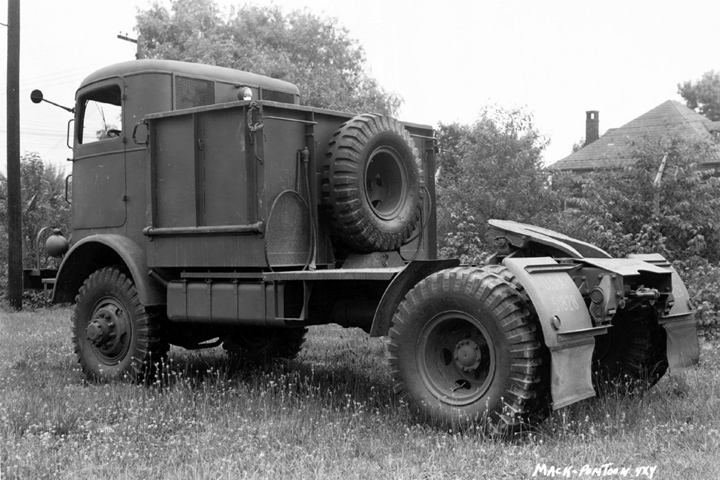
Image courtesy of Jeff Lakaszcyck added
12-13-2024.
Mack NM 6-ton 6x6 Trucks:
The National Museum of Military Vehicles has
two NM trucks. One is inside the Museum's hall of trucks, and
the other is outside awaiting restoration. Both are shown below.
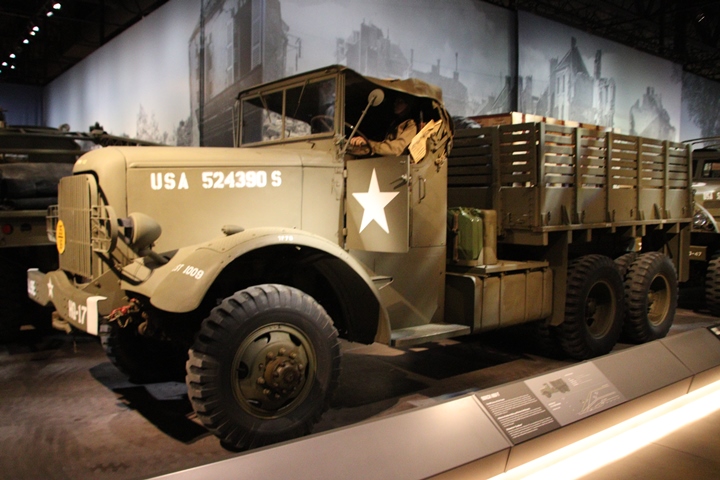
Author's photo added 12-13-2024.
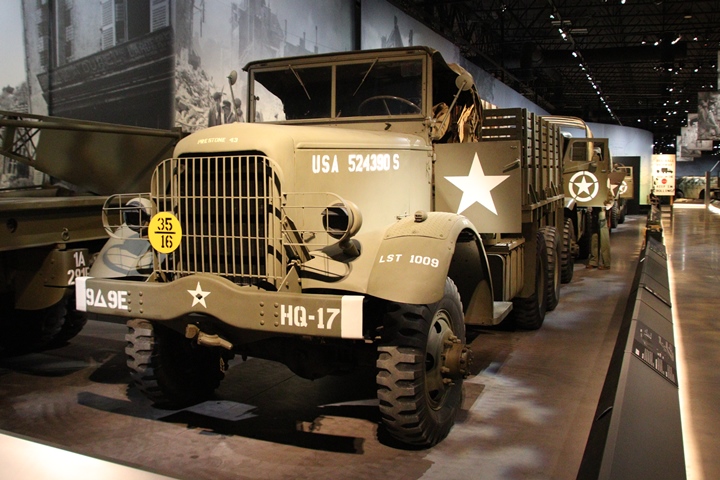
This vehicle has been identified by the
Museum as an Mack Model NM-7. Author's photo added 12-13-2024.
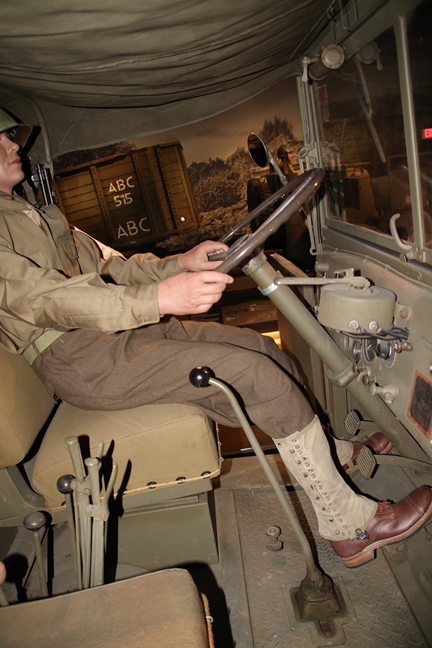
Author's photo added 12-13-2024.
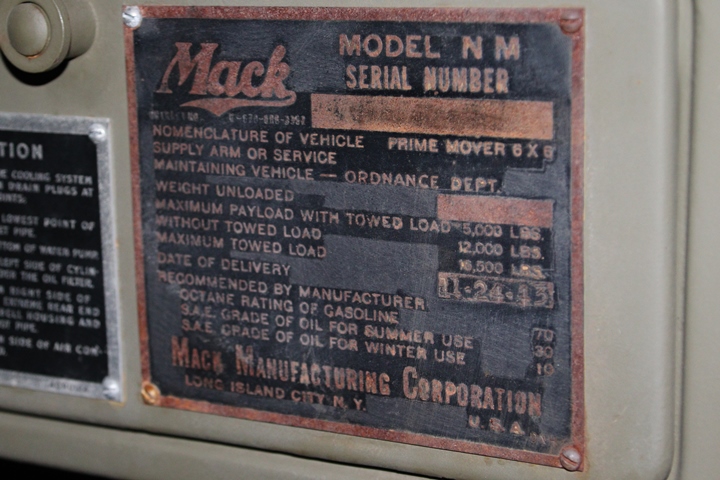
Author's photo added 12-13-2024.
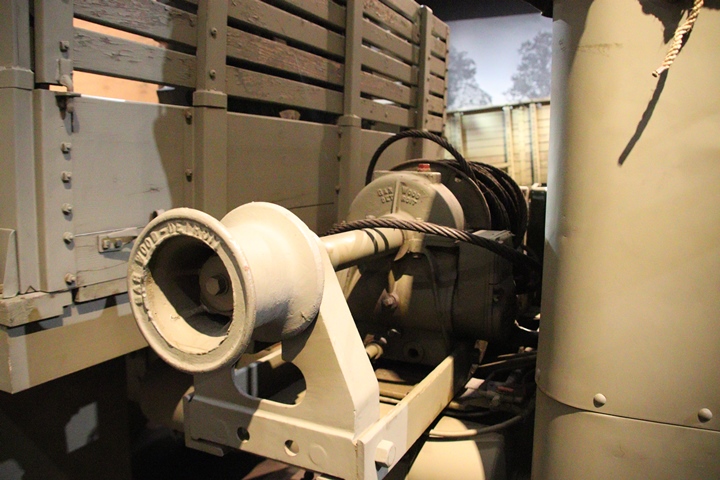
Author's photo added 12-13-2024.
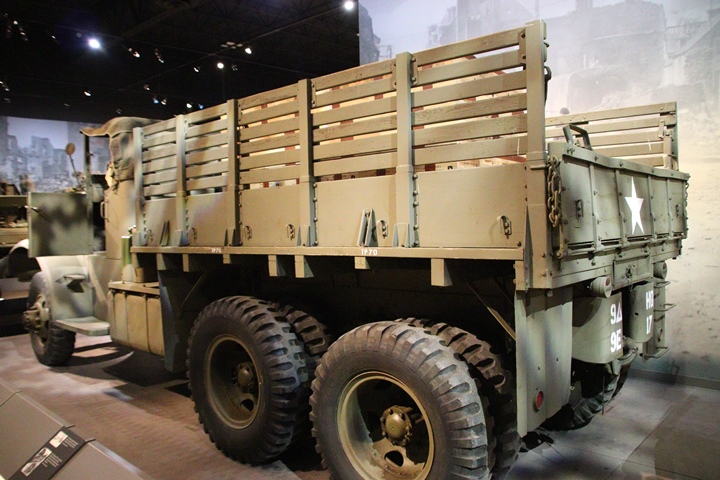
Author's photo added 12-13-2024.
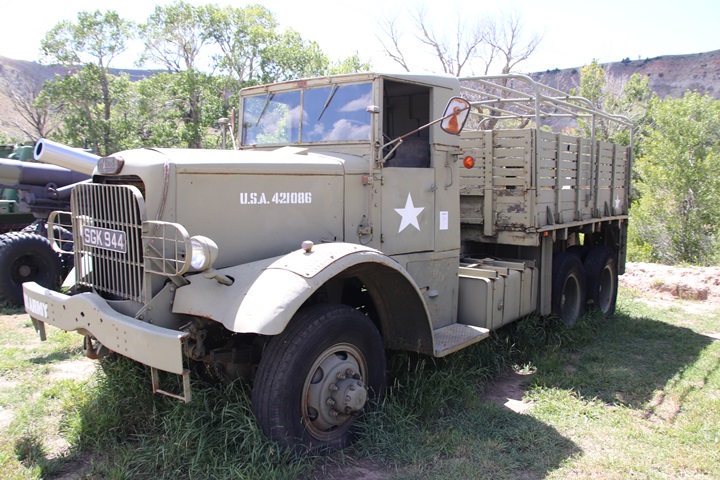
This NM-6 is parked outside along the Wind River at the
Museum. Author's photo added 12-13-2024.
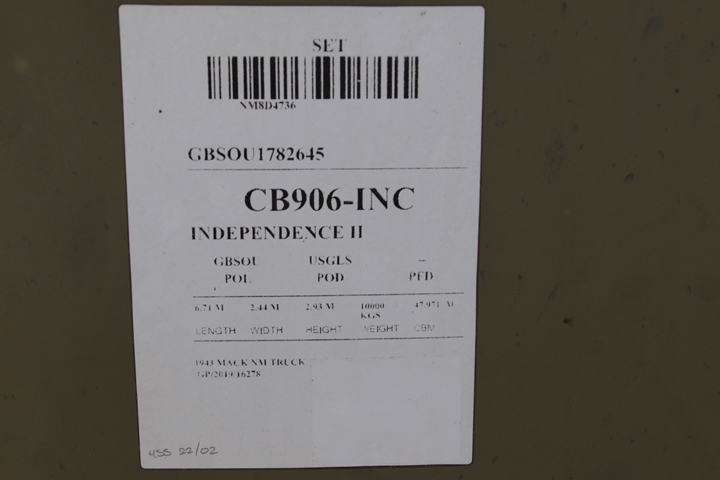
The
serial number NM8D4736 identifies this truck as an NM-6.
Author's photo added 12-13-2024.
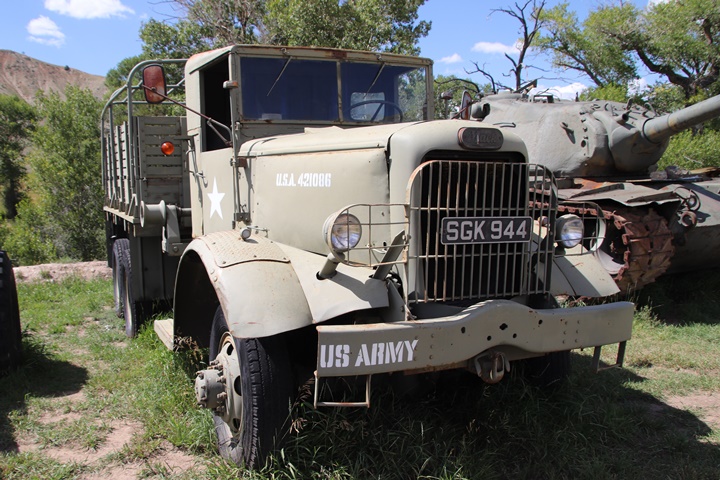
Author's photo added 12-13-2024.
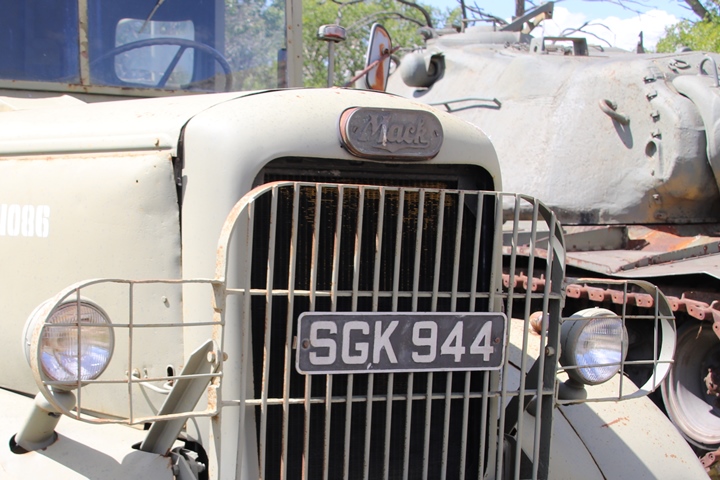
The Mack
nameplate did not come with the vehicle and has been added by a
post-World War Two era civilian owner.
Author's photo added 12-13-2024.
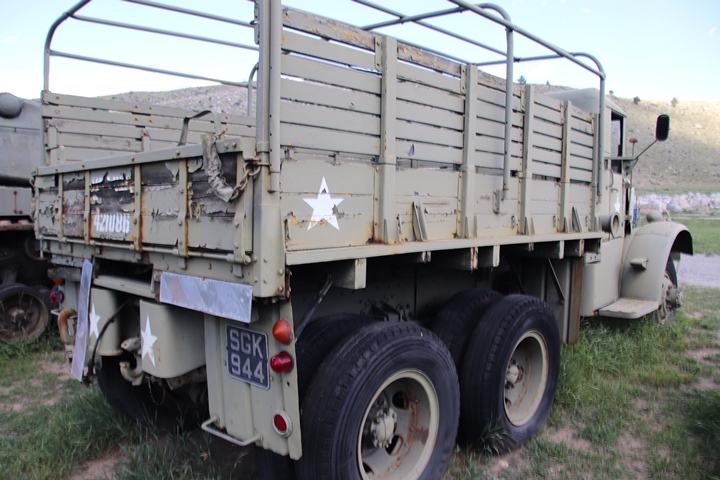
Author's photo added 12-13-2024.
Mack Truck Museum NM-8D 6-ton 6x6:
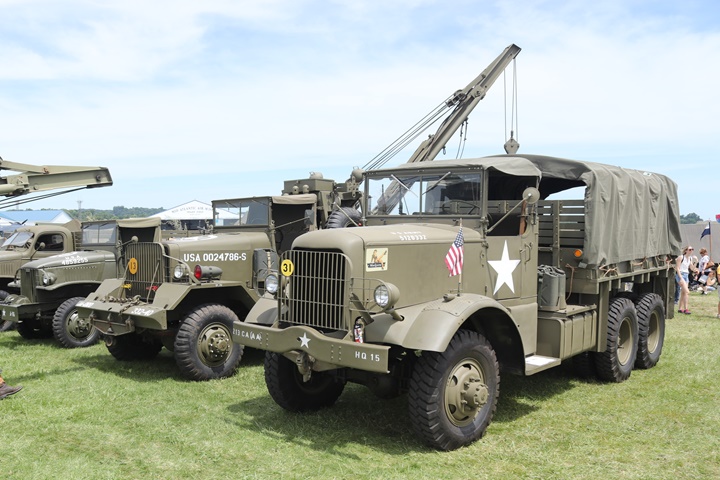
Size does matter! The Mack NM-8D 6-ton 6x6 compared to
Ward-LaFrance 10-ton wrecker and two GMC CCKW 2-1/2-ton trucks. The Mack
NM-8D was built on June 12,1945 and is Serial Number 7594. It is
owned by the Mack Truck Museum in nearby Allentown, PA. Author's photo added 7-11-2019.
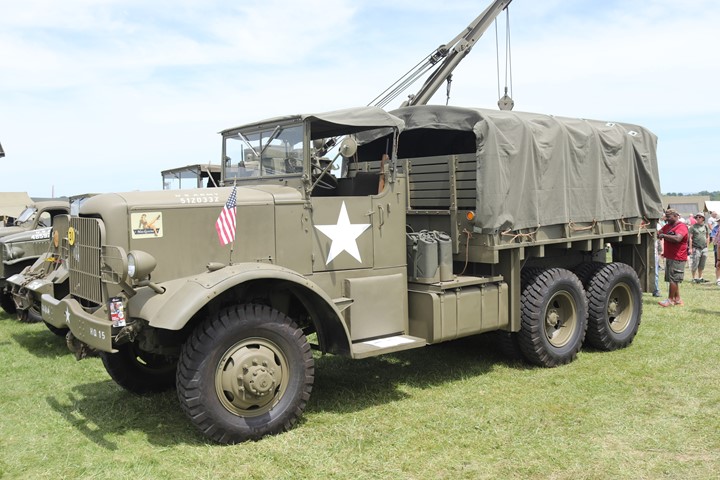
This truck was photographed at the 2019
World War Two Weekend at Reading, PA and was the truck's first appearance
at the event. From the data shown in production
tables below, most of the trucks that Mack built during the war were
sent to the United Kingdom. The major exception to this was the NO
Series 7-1/2-ton 6x6 Prime Movers that were used by the U.S. Army to
pull 155mm "Long Tom" artillery pieces. Author's photo
added 7-11-2019.
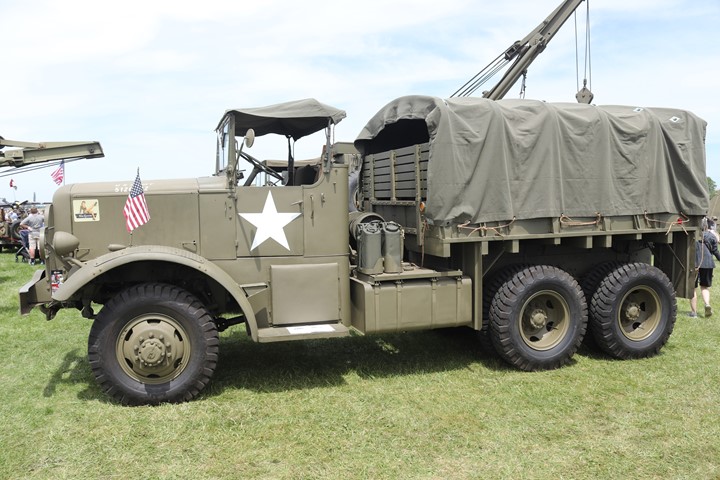
Author's photo added 7-11-2019.
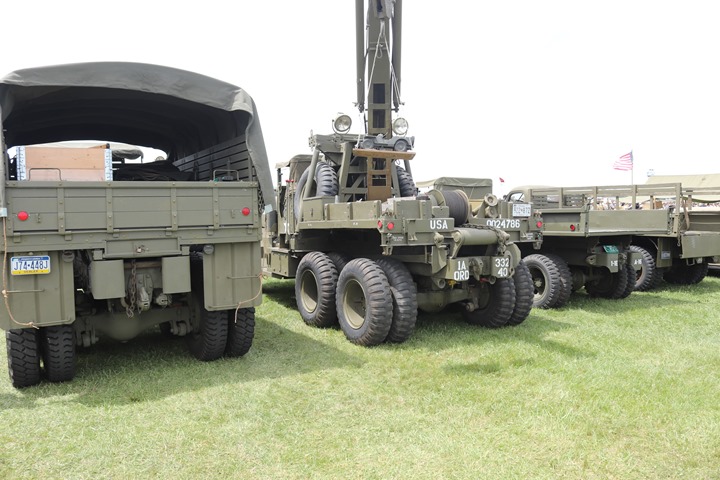
Author's photo added 7-11-2019.
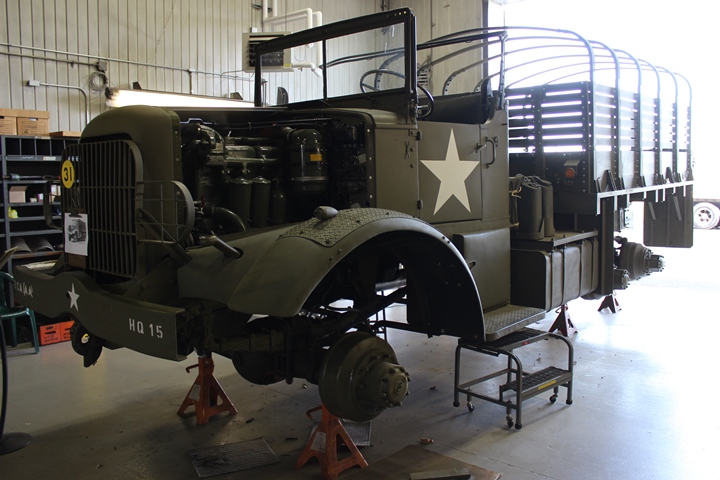
This is the same vehicle while undergoing
restoration at the Mack Truck Museum in September 2016. Author's
photo added 12-13-2024.
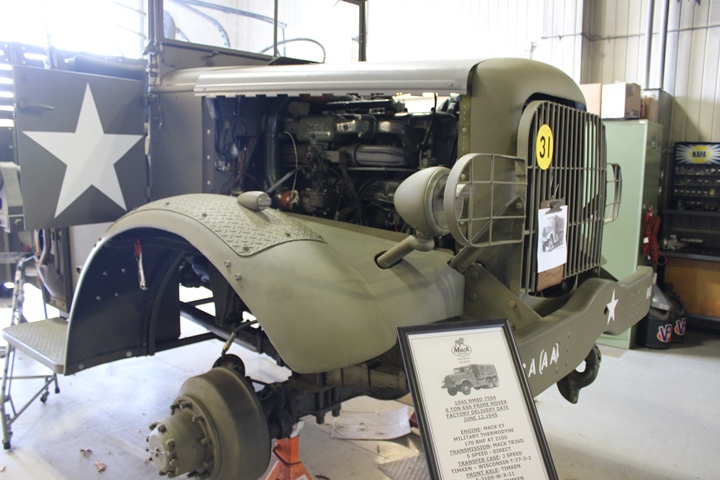
Author's photo added 12-13-2024.
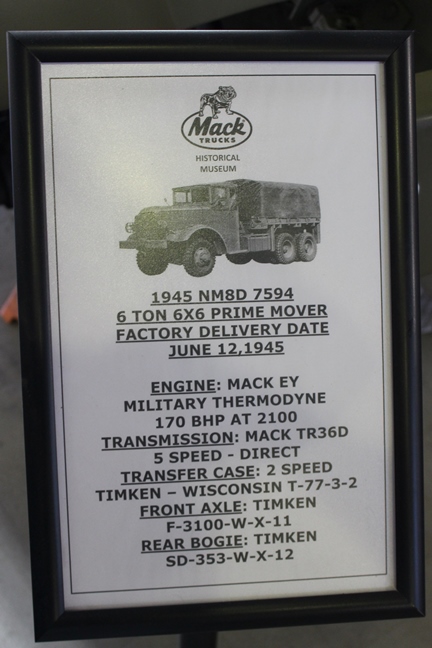
Author's photo added 12-13-2024.
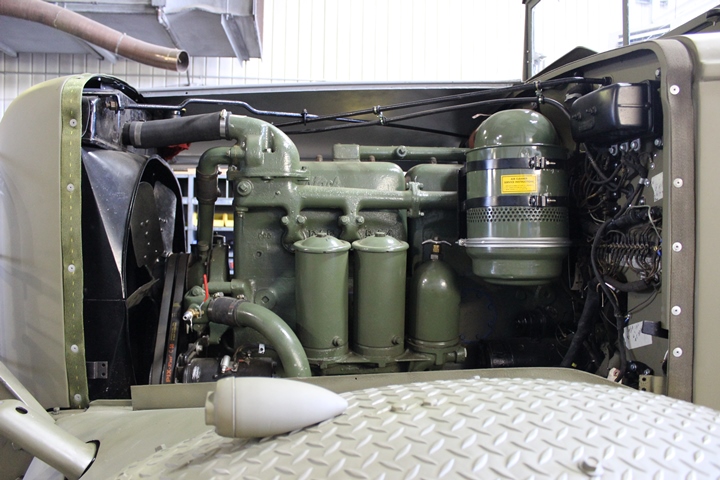
Author's photo added 12-13-2024.
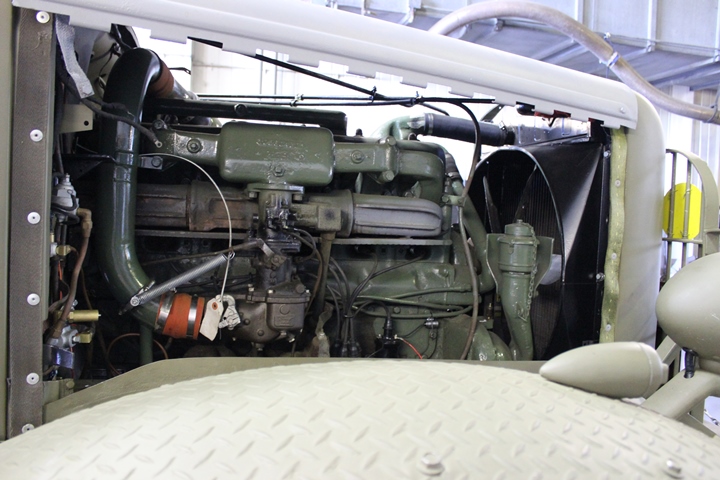
Author's photo added 12-13-2024.
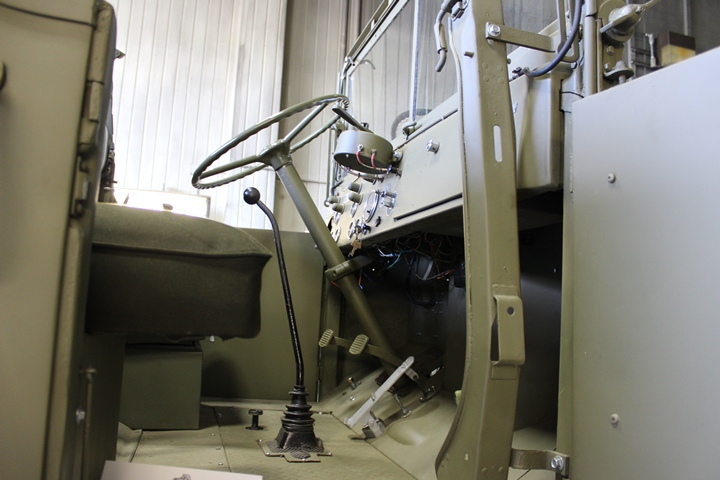
Author's photo added 12-13-2024.
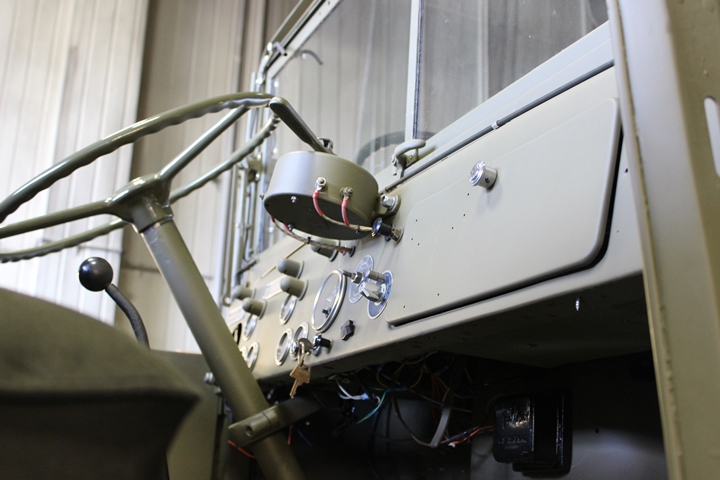
Author's photo added 12-13-2024.
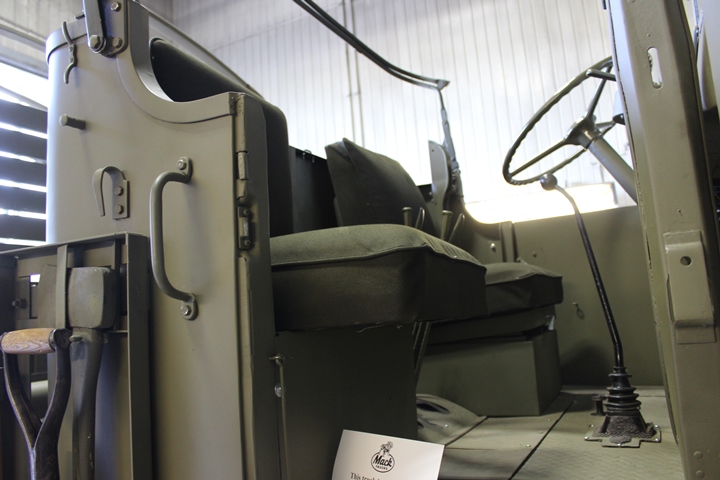
Author's photo added 12-13-2024.
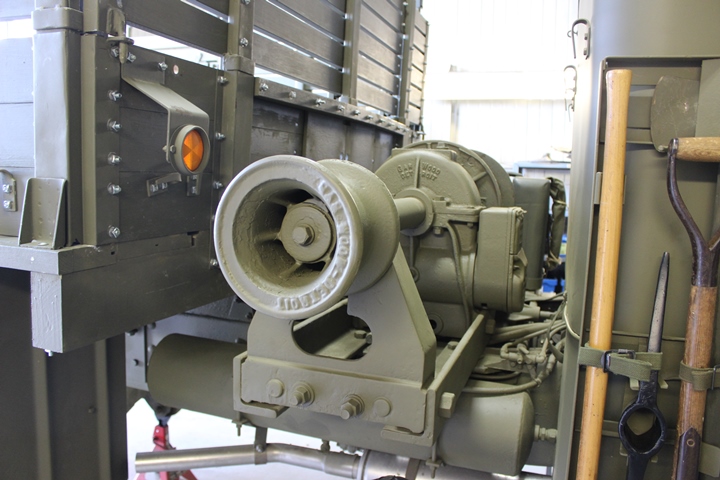
Author's photo added 12-13-2024.
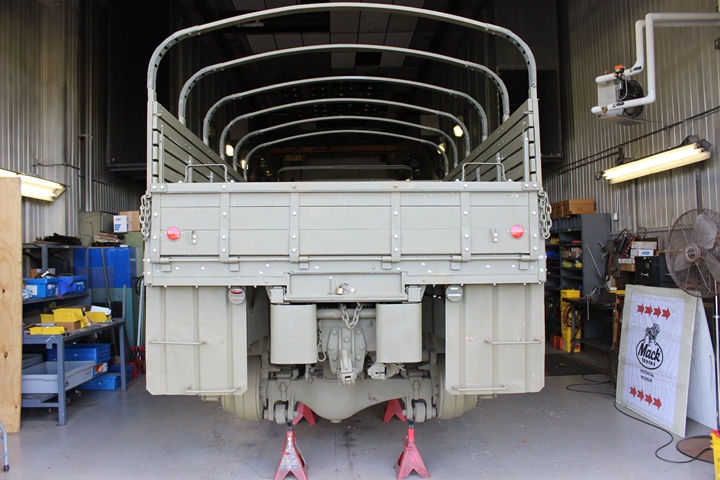
More photos of Mack NM-8D 7594:
This series of photos shows the same vehicle earlier in 2016 when it was
undergoing complete restoration at the Mack Truck Museum in Allentown,
PA. This 6-ton 6x6 prime mover had been used as a target at Fort
Indiantown Gap in Pennsylvania. Photos courtesy of Rudy Lev.
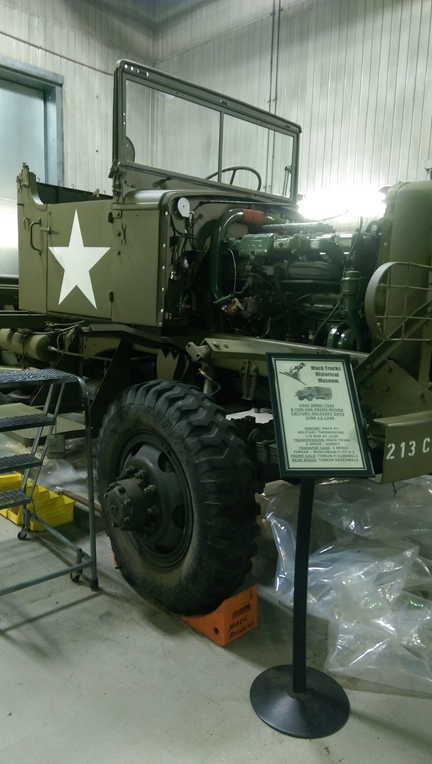
The tires have not been removed and the
vehicle is not up on jack stands as in the previous group of photos.
Photo courtesy of Rudy Lev added 6-14-2016.
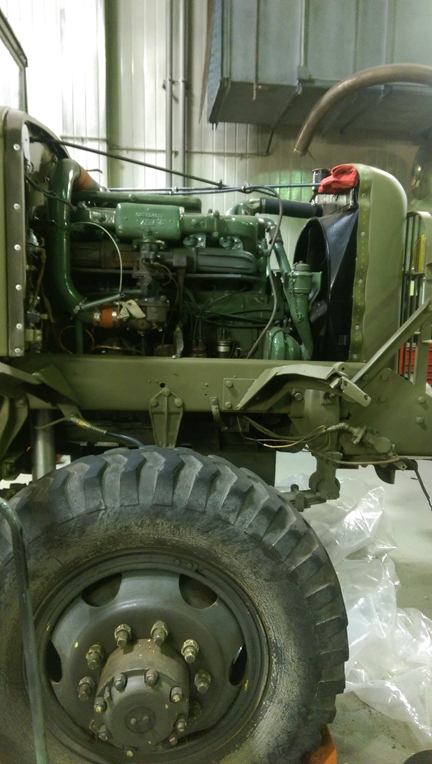
Photos courtesy of Rudy Lev added 6-14-2016.
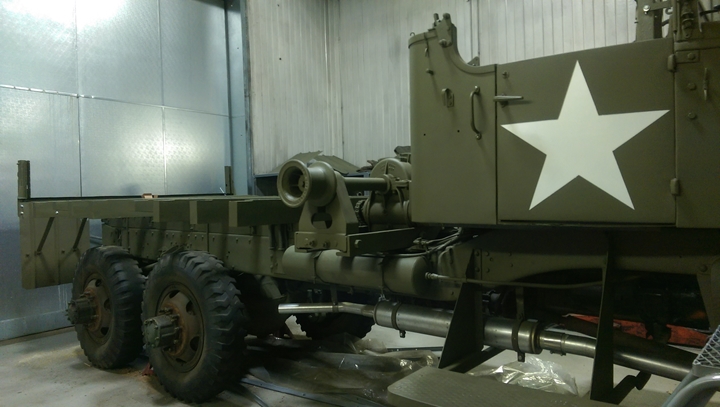
Also the bed has not been installed onto the
truck frame. Photos courtesy of Rudy Lev added 6-14-2016.
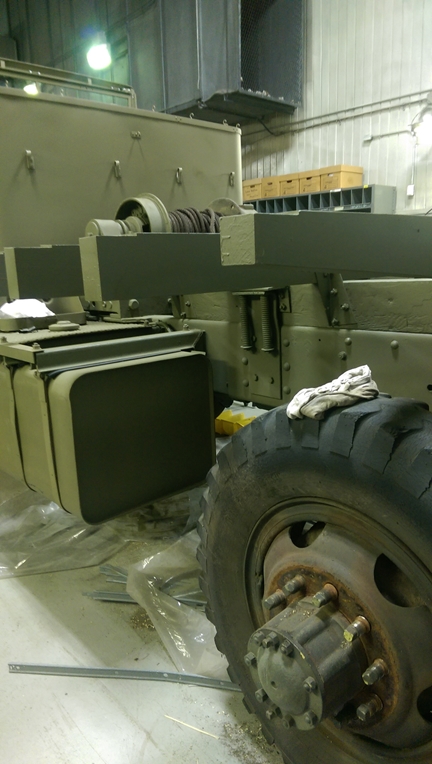
Photos courtesy of Rudy Lev added 6-14-2016.
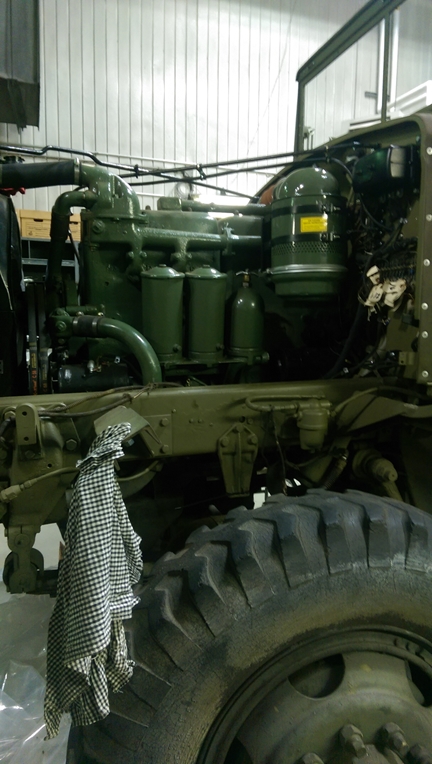
Photos courtesy of Rudy Lev added 6-14-2016.
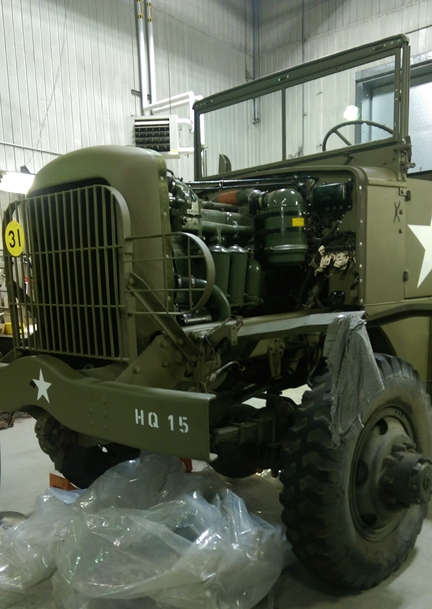
Photos courtesy of Rudy Lev added 6-14-2016.
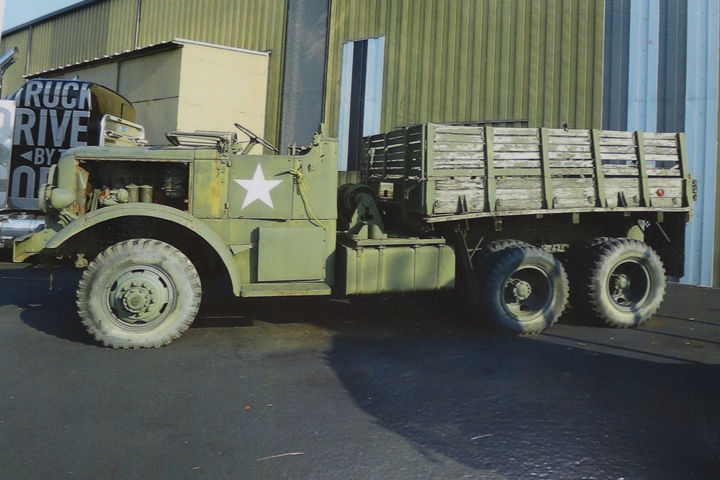
Now that we have seen the final results and
the truck during restoration, this shows us what the museum workers and
volunteers had to start with. Photo courtesy of the Mack Truck
Historical Museum added 12-13-2024.
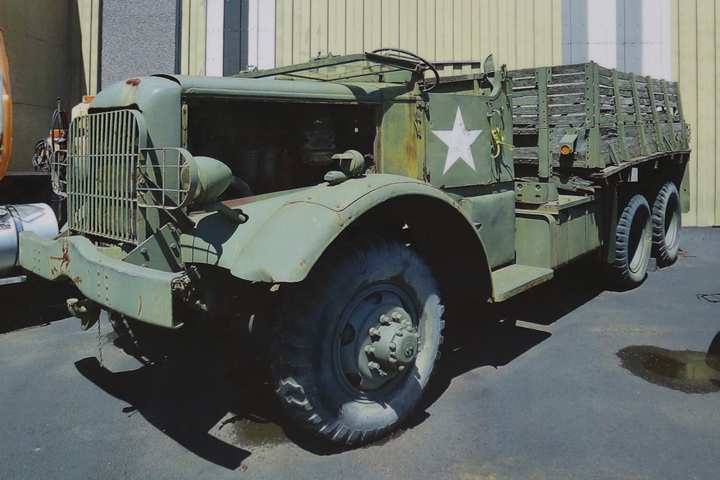
Photo courtesy of the Mack Truck Historical
Museum added 12-13-2024.
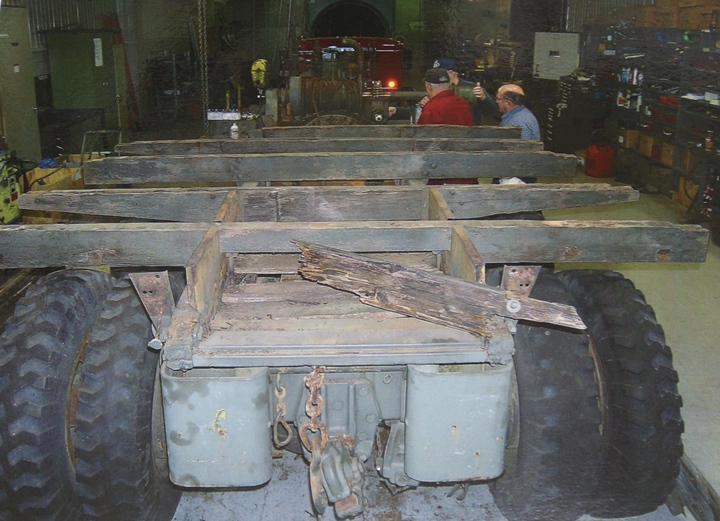
Photo courtesy of the Mack Truck Historical
Museum added 12-13-2024.
Mack NO 7-1/2-ton 6x6 Truck:
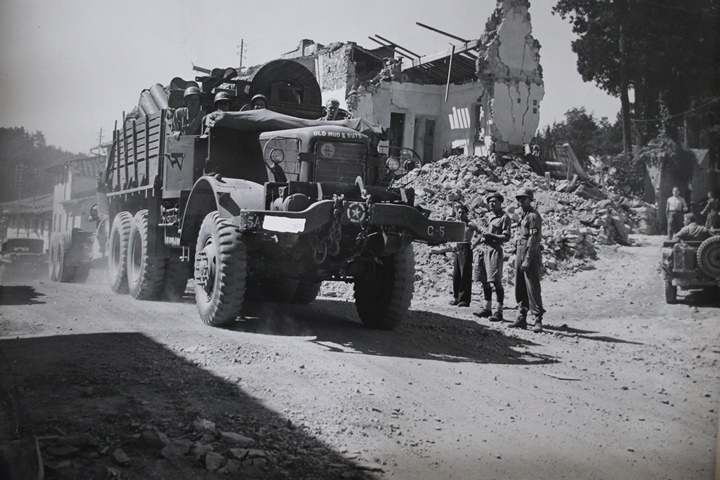
This photo has another Mack NO pulling a
155mm gun through a bombed out town in Europe. Photo courtesy of
the R.E. Old Transportation Museum added 12-24-2021.
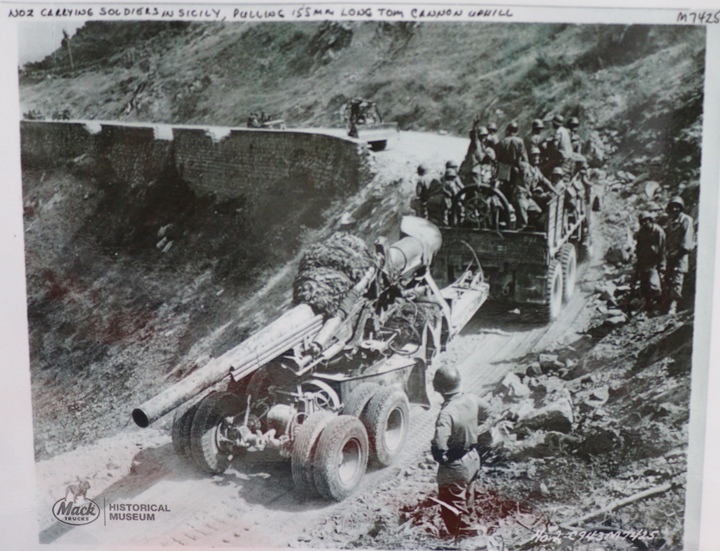
Photo courtesy of the Mack Truck Historical
Museum added 12-13-2024.
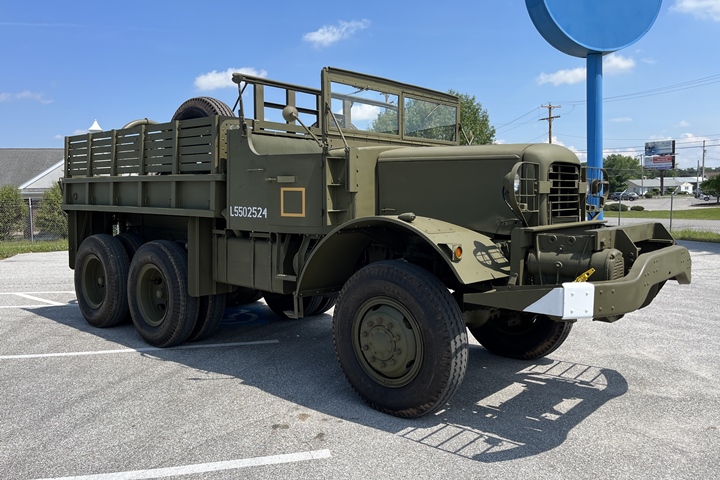
Here are more photos of John Gott's
excellent looking NO-7. Image courtesy of Jeff Lakaszcyck added
12-13-2024.
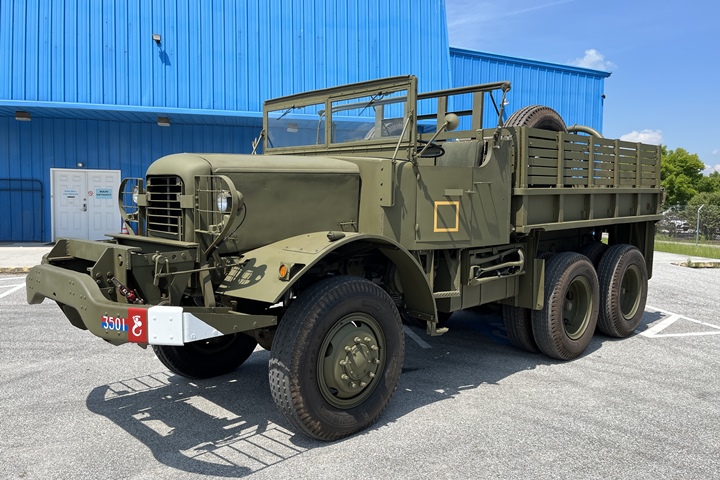
Image courtesy of Jeff Lakaszcyck
added 12-13-2024.
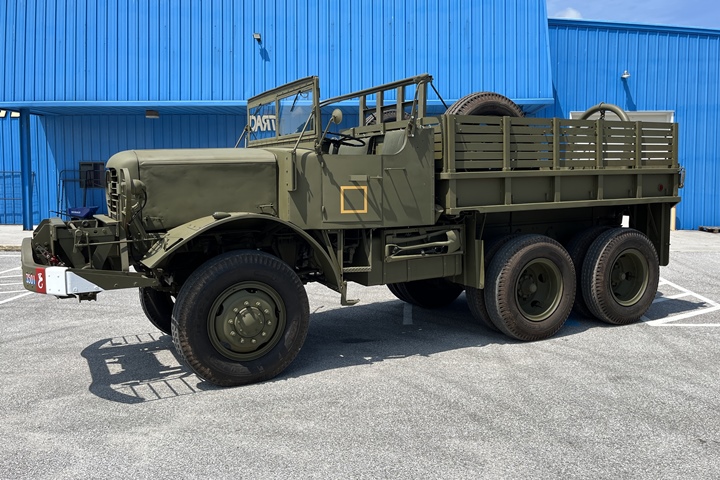
Image courtesy of Jeff Lakaszcyck
added 12-13-2024.
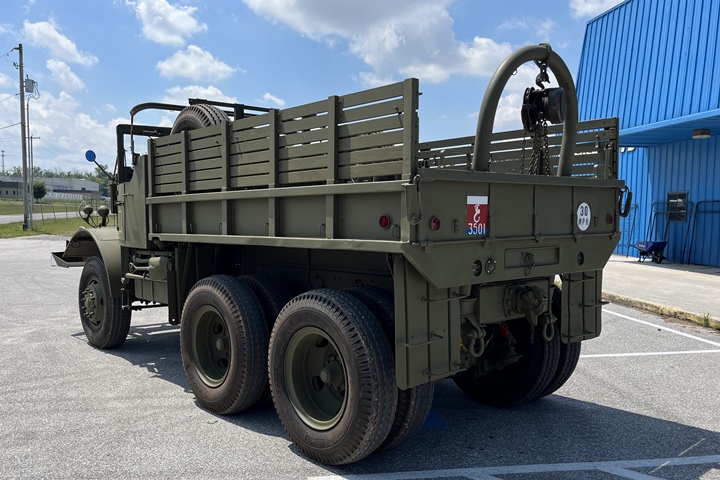
Image courtesy of Jeff Lakaszcyck
added 12-13-2024.
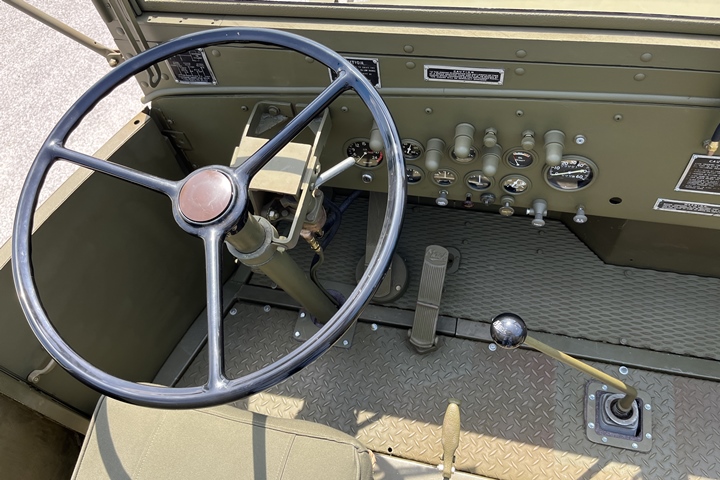
Image courtesy of Jeff Lakaszcyck
added 12-13-2024.
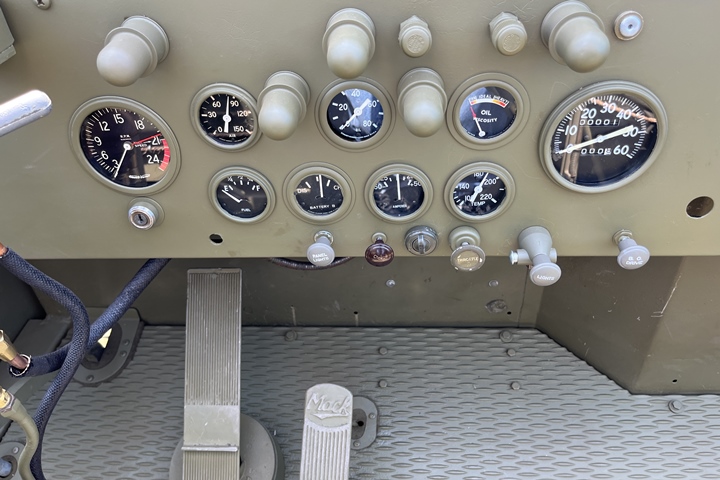
Image courtesy of Jeff Lakaszcyck
added 12-13-2024.
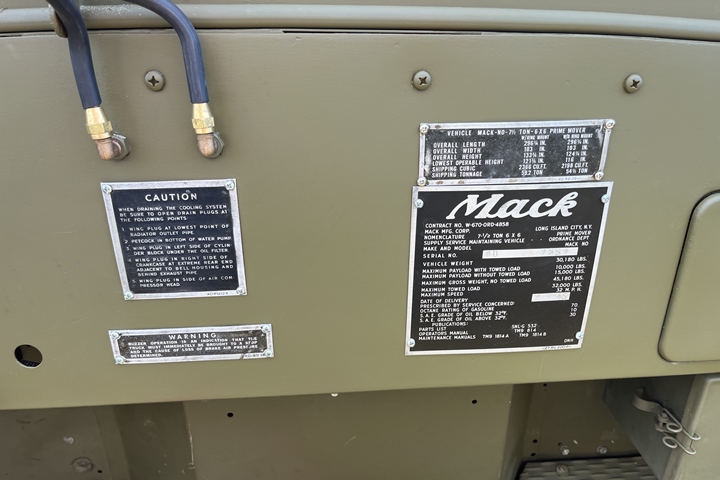
Image courtesy of Jeff Lakaszcyck
added 12-13-2024.
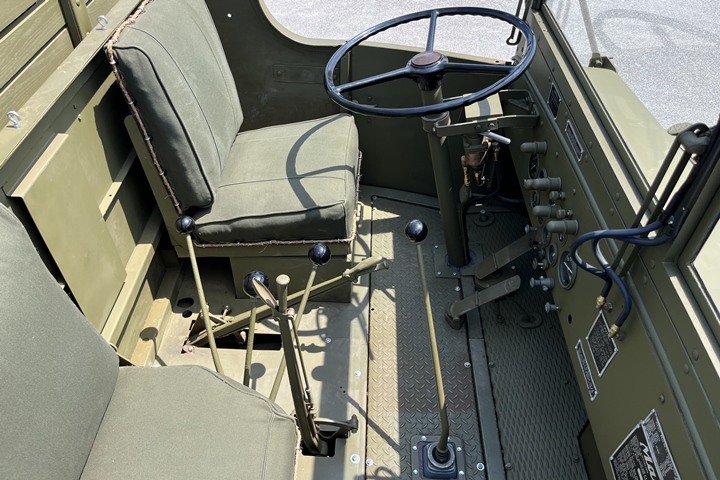
Image courtesy of Jeff Lakaszcyck
added 12-13-2024.
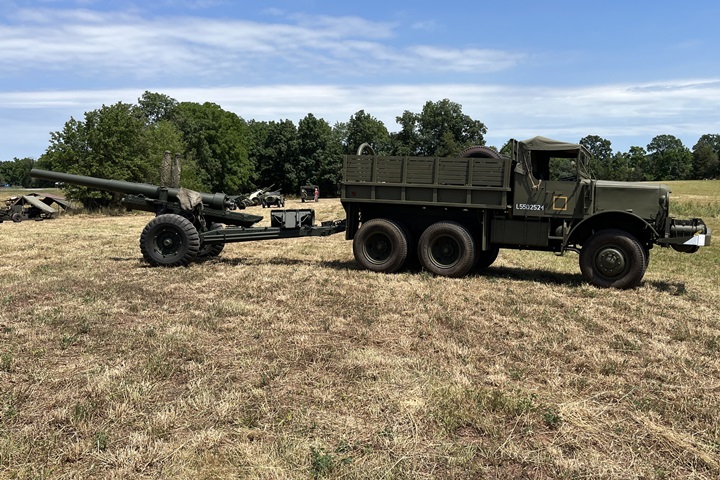
Image courtesy of Jeff Lakaszcyck
added 12-13-2024.
Mack NR 10-ton 6x4 Truck:
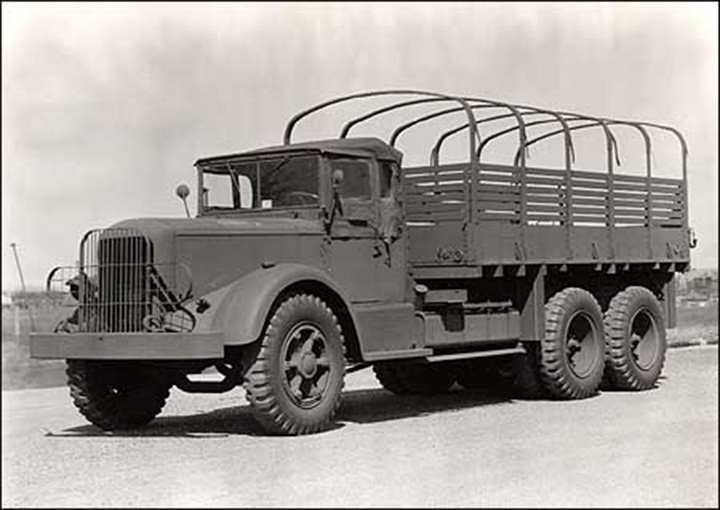
This early World War Two factory photo shows the
Mack Model NR 10-ton truck. Photo courtesy of the Mack Truck
Historical Museum.
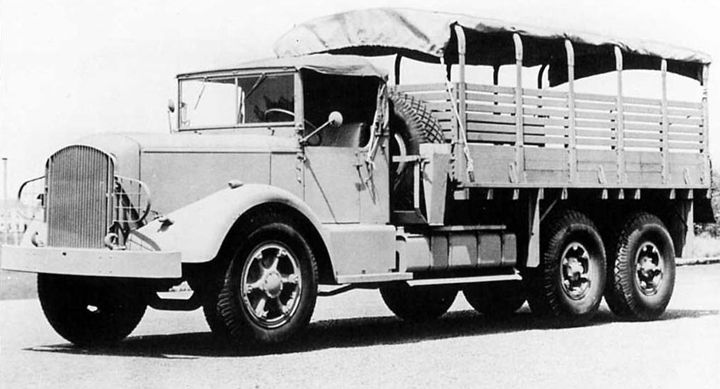
Note that this Mack Model
NR-9 has a different shaped radiator bush guard and spare tires behind
the cab. This one is painted in desert tan. Image courtesy
of Jeff Lakaszcyck
added 12-13-2024.
Shipping space on ships was at a premium
during World War Two. Therefore truck manufacturers, once they had
built a truck and tested it, would then disassemble the vehicle, and pack
it in a wooden crate that took up less volume in a ship. These
were known as knock-downs and would be re-assembled once they arrived at
their theater of operation. Below is a series of photos that show
the packing of both an NR-9 and an NR-14.
The NR-9 shown above was packed into the
shipping crate shown below. Once packing was complete, the entire
crate was enclosed with wood, totally protecting the truck inside.

Mack plant 11 was the location of the
repacking operation. This photo identifies this as an NR-9.
Photo courtesy of the Mack Truck Historical Museum added 12-13-2024.
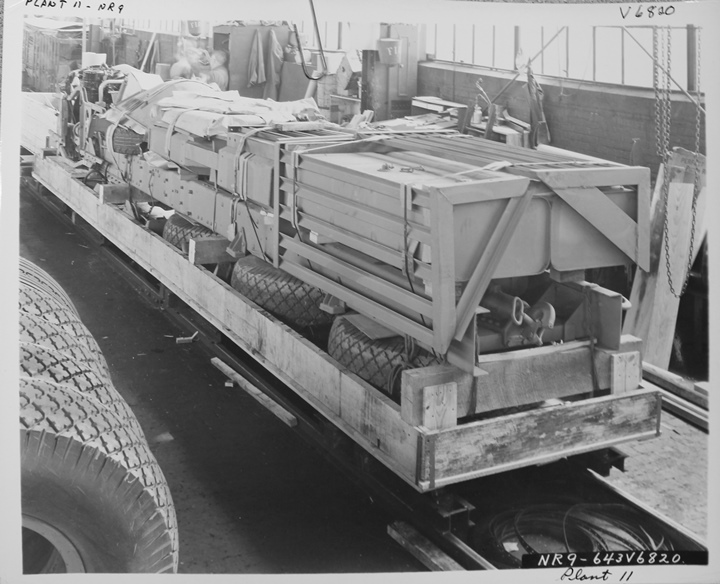
Photo courtesy of the Mack Truck Historical
Museum added 12-13-2024.
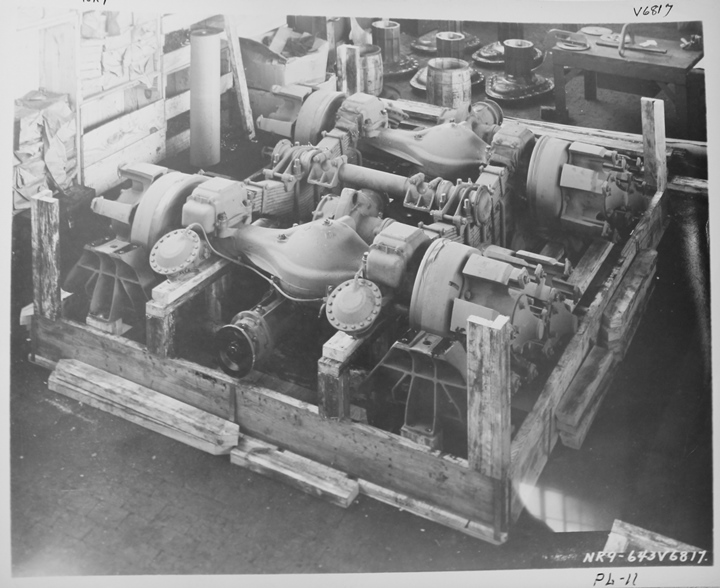
Photo courtesy of the Mack Truck Historical
Museum added 12-13-2024.
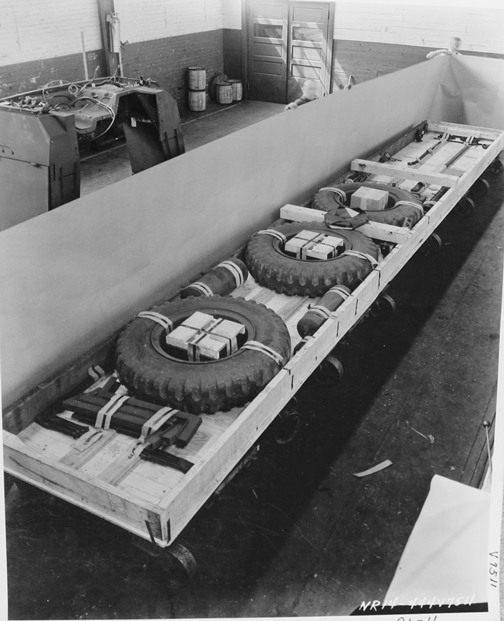
This series of photos shows the packing of
an NR-14. Photo courtesy of the Mack Truck Historical Museum added
12-13-2024.
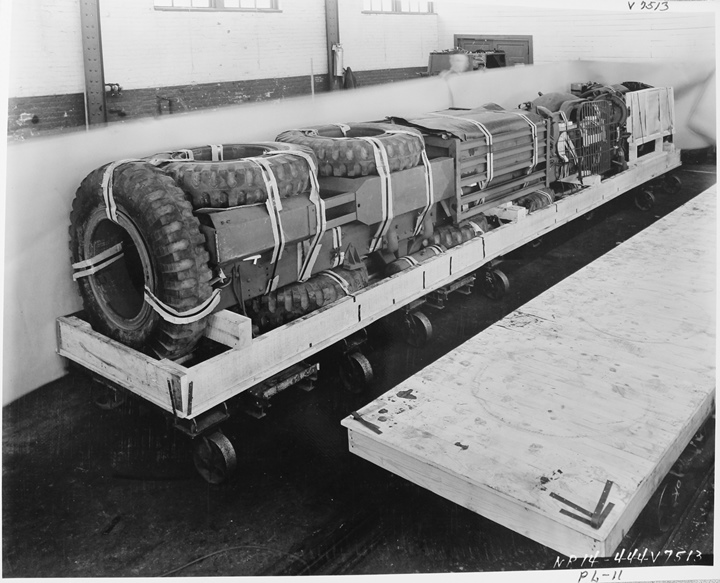
Photo courtesy of the Mack Truck Historical
Museum added 12-13-2024.
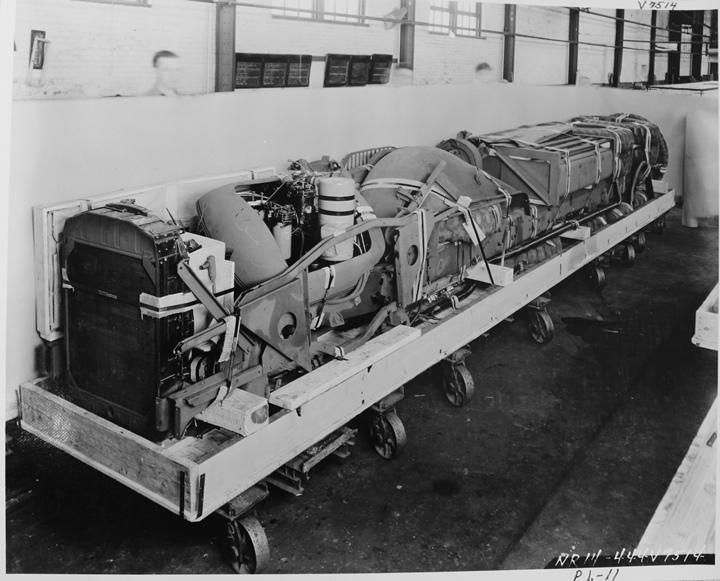
Photo courtesy of the Mack Truck Historical
Museum added 12-13-2024.
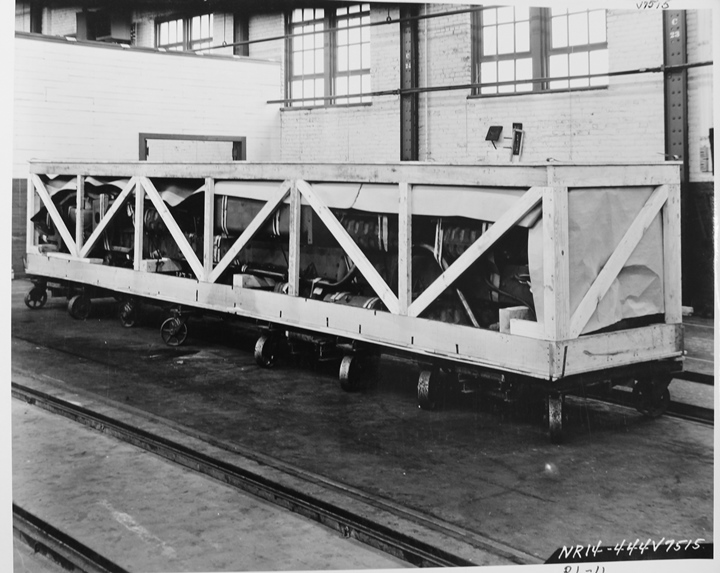
Photo courtesy of the Mack Truck Historical
Museum added 12-13-2024.
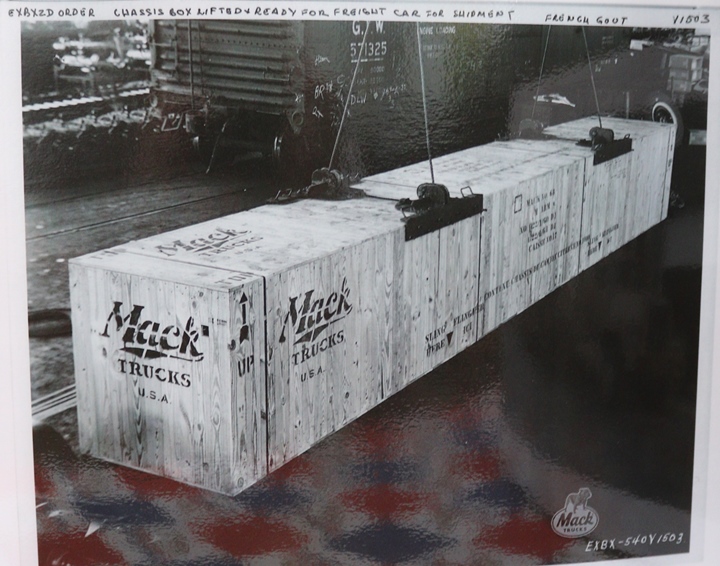
This image shows a completely boxed
knock-down. Compare its size with the second photo below.
Photo courtesy of the Mack Truck Historical Museum added 12-13-2024.
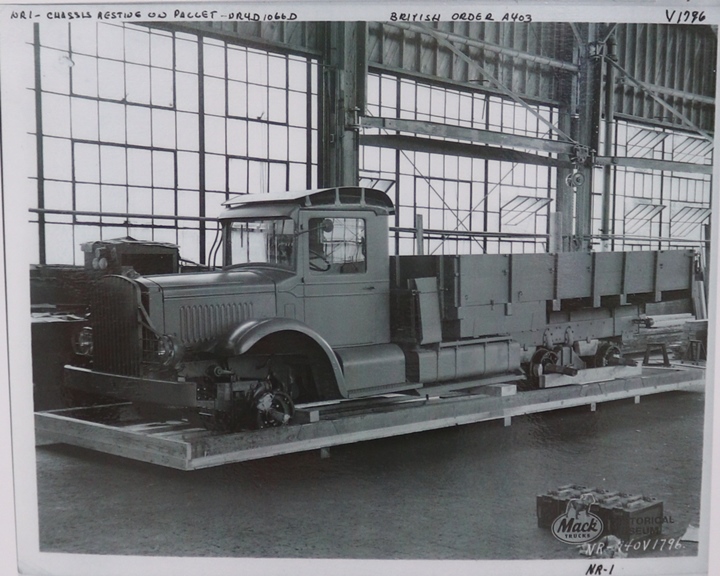
Early in the war the trucks were not
completely disassembled but only had the wheels and tires removed as is
the case for this NR-1. Photo courtesy of the Mack Truck
Historical Museum added 12-13-2024.
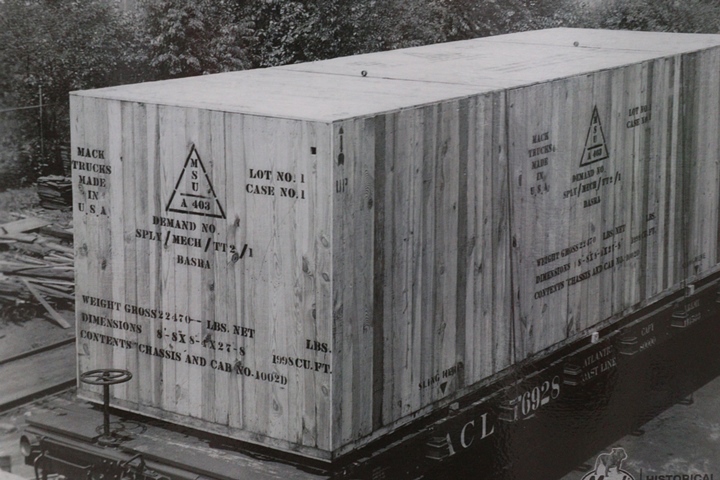
This finished shipping crate shows how much
extra space was used than the ones shown above. It can be seen why the extra
effort was taken to do complete knock-downs on trucks. Photo
courtesy of the Mack Truck Historical Museum added 12-13-2024.
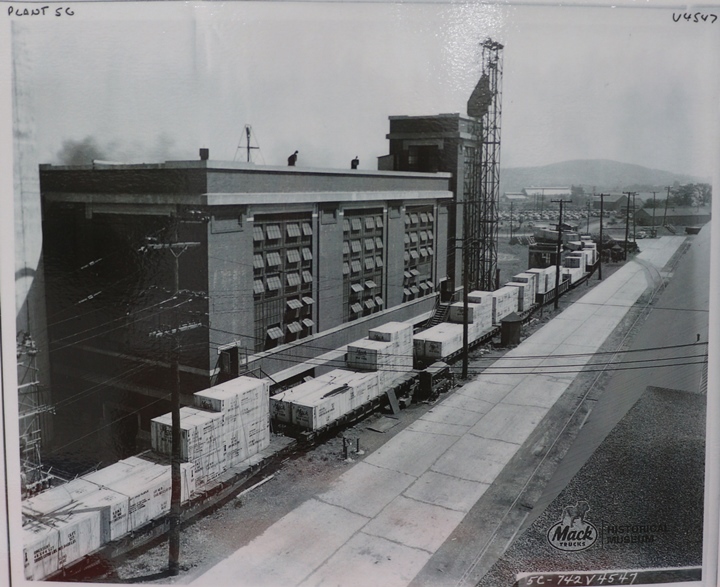
Here, a train load of boxed trucks leaves the
factory complex. Photo courtesy of the Mack Truck Historical
Museum added 12-13-2024.
EH Series 5-6-ton 4x2 Cargo Trucks: Below are three World War
Two era factory photos showing two of the Mack EH series of trucks.
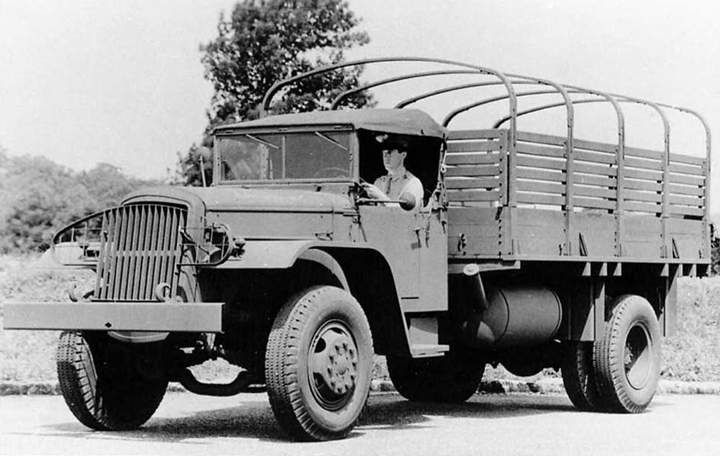
This Mack factory photo shows a 1943 EH
cargo truck. Image courtesy of Jeff Lakaszcyck
added 12-13-2024.
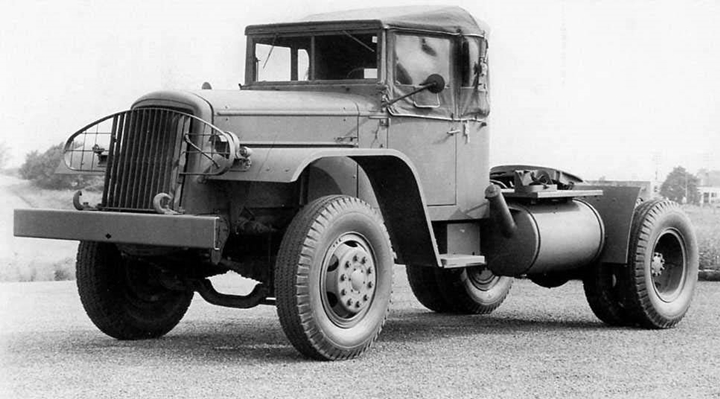
This photo shows the 1943 EHT tractor
version of the EH series. Image courtesy of Jeff Lakaszcyck
added 12-13-2024.
Mack-built M3 Grant/Lee Tank
Transmissions and Final Drives:
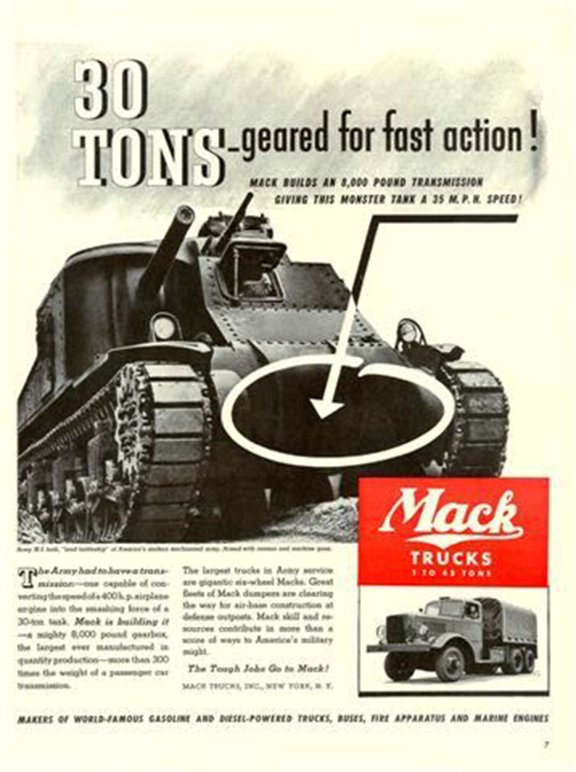
The 2,600 tank transmissions went into the
M3 Lee/Grant tank. The historical record is unclear
whether Mack built the transmission, or final drive, or both.
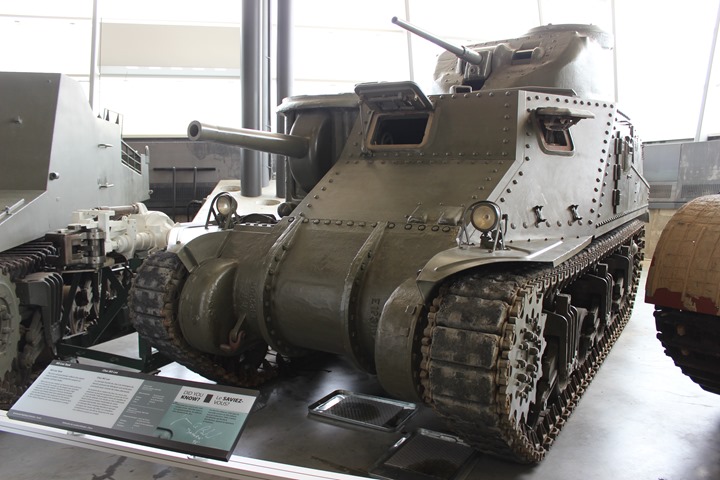
The Mack-built transmissions were at the
front of the M3 tank. Author's photo added 2-16-2016.
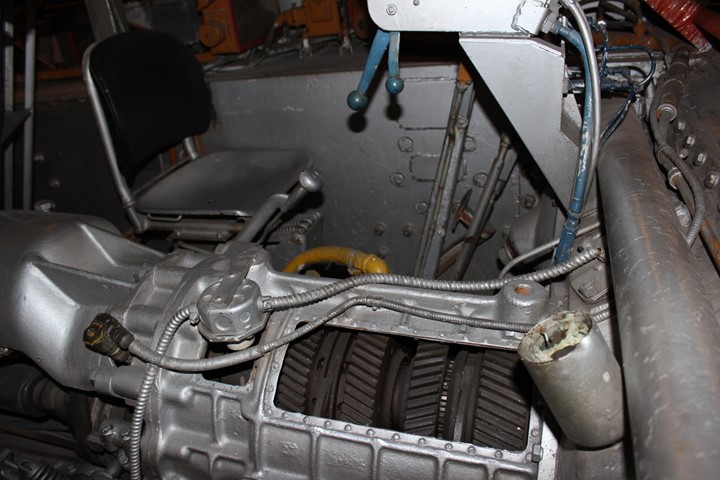
Looking inside a cut-away tank at the Canadian War Museum in Ottawa, ONT,
one can view the M4A2 Sherman transmission inside the tank. This
was located to the right of the driver's position in the
background. The M3 and M4 series medium tanks used the same
transmission and final drive. Author's photo added 7-7-2020.
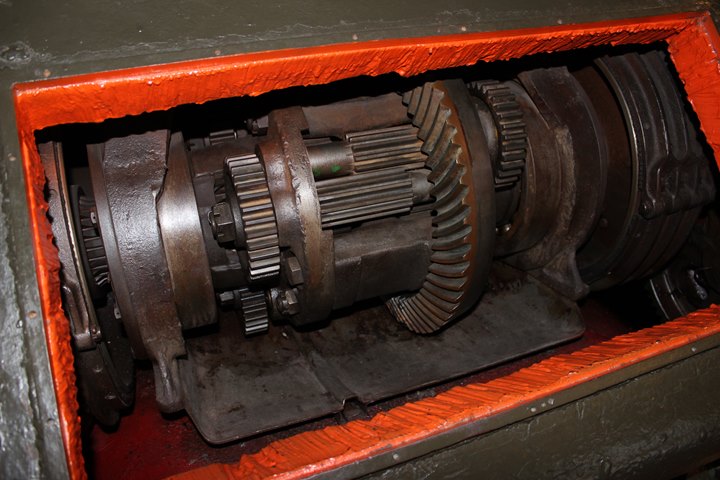
The next two photos show the internal gears
and brakes that Mack manufactured before assembling them into the final
drive unit. Author's photo added 7-7-2020.
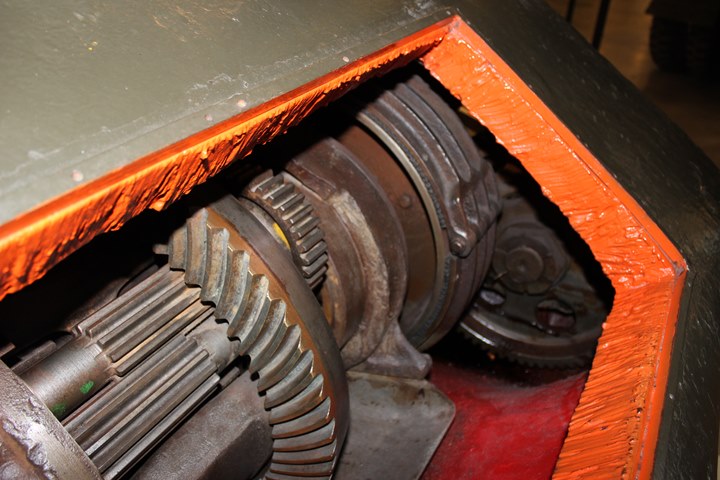
Author's photo added 7-7-2020.
The Plants:

This undated photo shows the Mack
Manufacturing Corporation at its peak. Photo courtesy of the Mack Truck Historical
Museum added 12-13-2024.
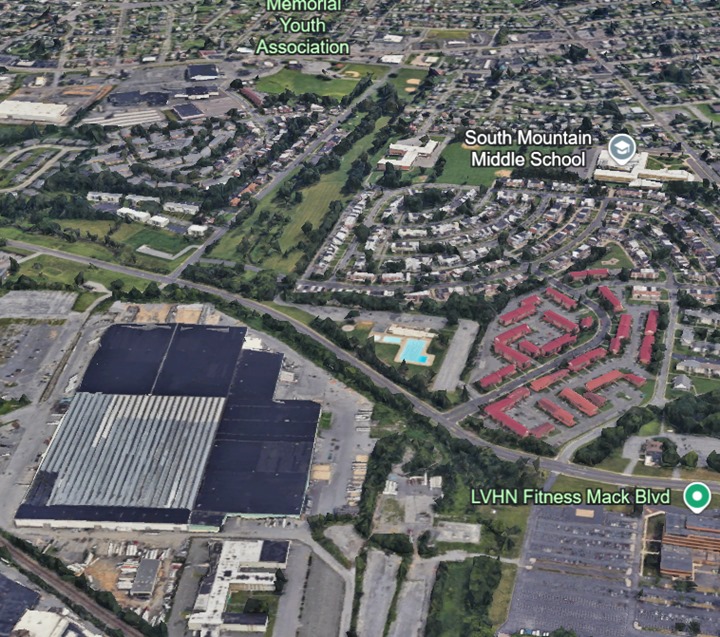
This current Google Earth satellite image
shows that only the final assembly plant remains. Mack no longer
owns this building and moved its final assembly to the new plant in
nearby Lehigh Valley. Image added 12-13-2024.
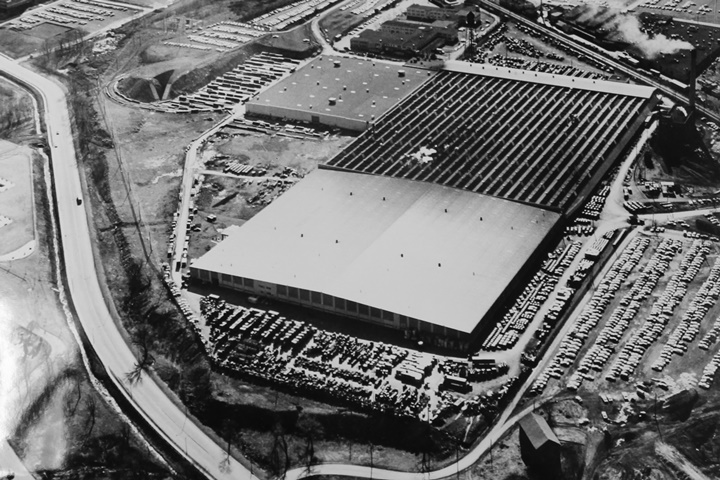
This image shows the former final assembly
plant in Allentown with an addition. Photo courtesy of the Mack Truck Historical
Museum added 12-13-2024.
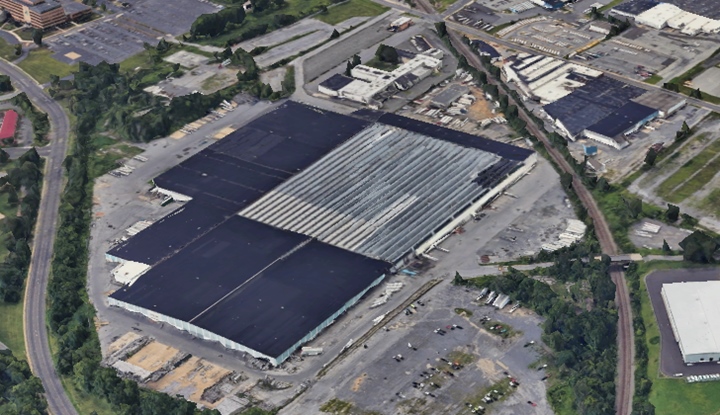
This current Google Earth view shows the
vacated plant as it is today. There was a project to reuse the
plant for other purposes, but this appears not to have occurred.
Image added 12-13-2024.
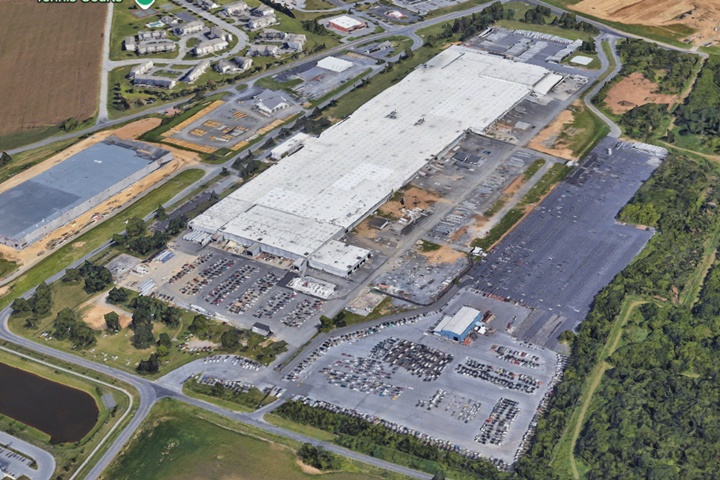
This is the current Mack final assembly
plant in Pennsylvania located in the Lehigh Valley. Image courtesy
of Google Earth added 12-13-2024.
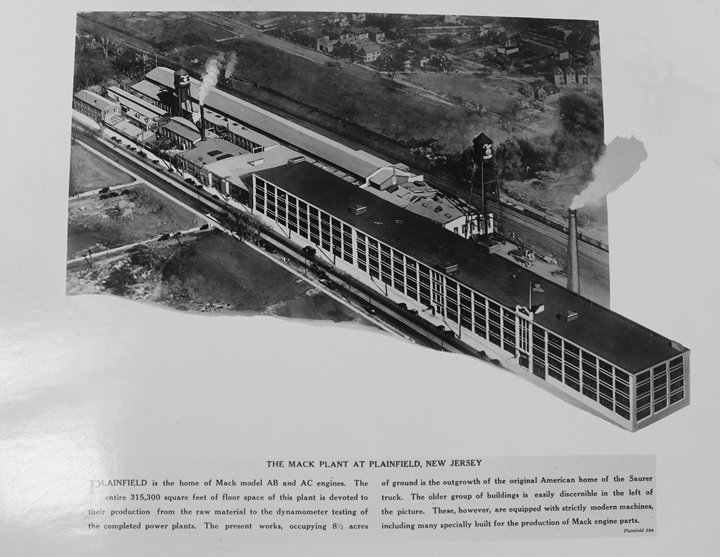
This and the image below are of the
Plainfield, NJ plant. The one below is a new view as it has more
buildings. Photo courtesy of the Mack Truck Historical
Museum added 12-13-2024.
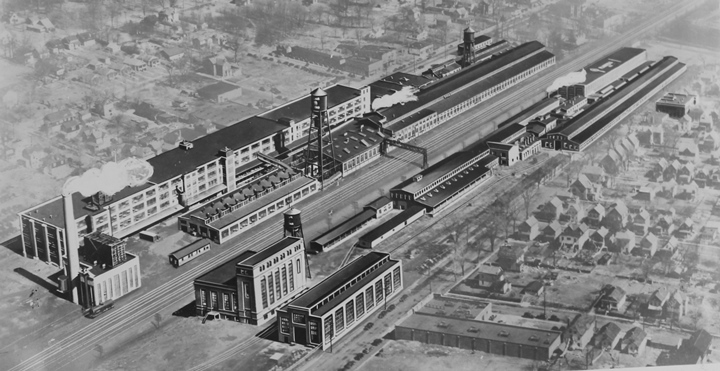
Mack purchased the plant in 1911 and
closed it in 1961, with the opening of its new Hagerstown, MD plant. Photo courtesy of the Mack Truck Historical
Museum added 12-13-2024.
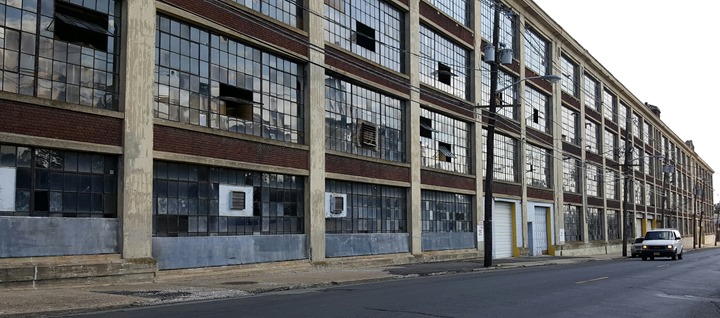
Manufacturing historian Rudy Lev visited the
former Mack plant in Plainfield, NJ and provided these ground level
shots of the facility. Image courtesy of Rudy Lev added 12-13-2024.

Old truck factories never die, they just
find new life as space to cultivate cannabis. In June 2023 the New
Brunswick planning board approved the use of 137,423 square feet of the
former truck plant for cannabis cultivation. This is the size of
2.5 football fields. This is the second former truck factory I
know of doing this, the other being one of the old Reo plants in
Lansing, MI. Image courtesy of Rudy Lev added
12-13-2024.
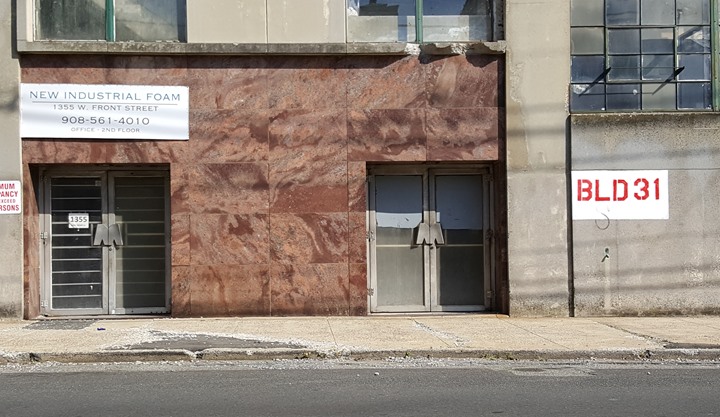
Image courtesy of Rudy Lev added 12-13-2024.
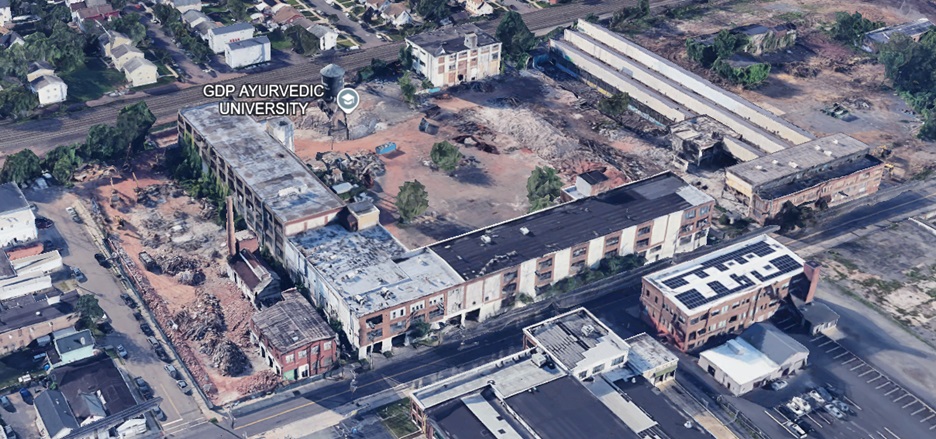
Mack owned this plant in New Brunswick, NJ
which was purchased from the Wright-Martin Aircraft Company in 1919.
During World War One, the plant produced 5,816 Hispano-Suizas
aircraft engines under license and 51 aircraft. After the World
War One,
Mack bought the plant and the equipment in it. This plant produced
transmissions and drive train components. The plant closed in 1962
when the new Hagerstown, MD plant opened.
This Google Earth view dated 8-2-2023 shows
the plant being razed. Image added 12-13-2024.
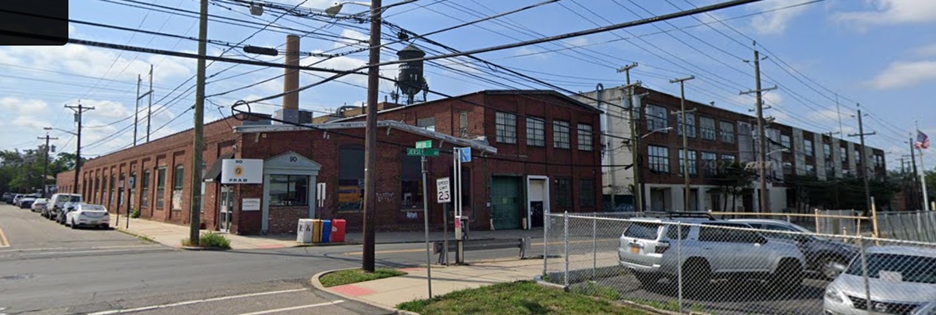
The location for the plant was at the intersection of Jersey Avenue and
Sanford Streets in New Brunswick, NJ. This Google Maps street view
dated June 2021 shows the plant before demolition began. Image
added 12-13-2024.
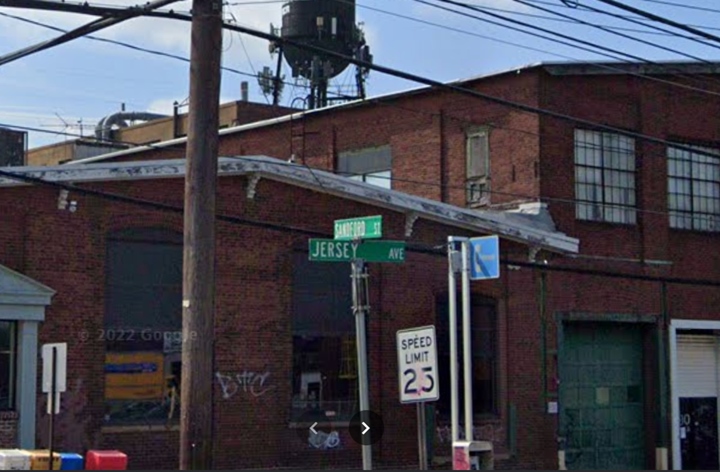
Image courtesy of Google Maps added 12-13-2024.
Post-World War Two Mack Military Trucks:
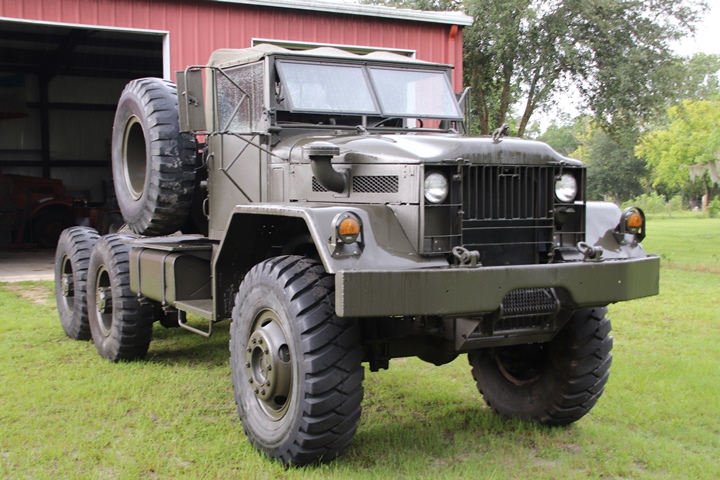
Truck historian and collector Jeff Lakaszcyck
has this fully restored and pristine 1968 M123A1C as part of his
collection. Author's photo added 12-13-2024.
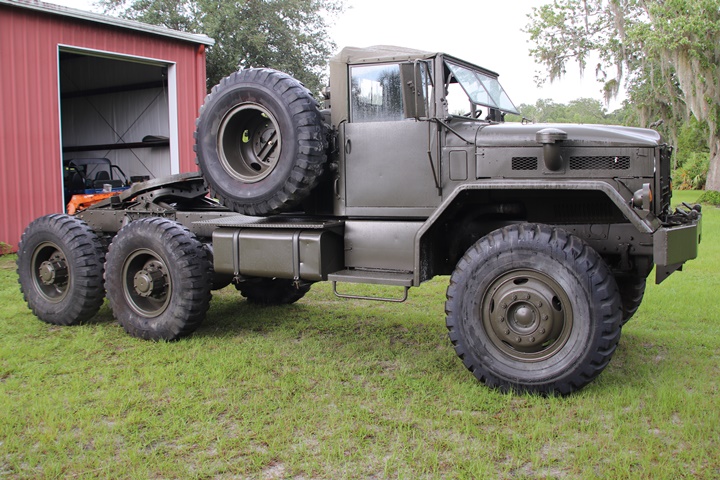
The truck is powered by a
Cummins V8-300 diesel engine.
Author's photo added 12-13-2024.
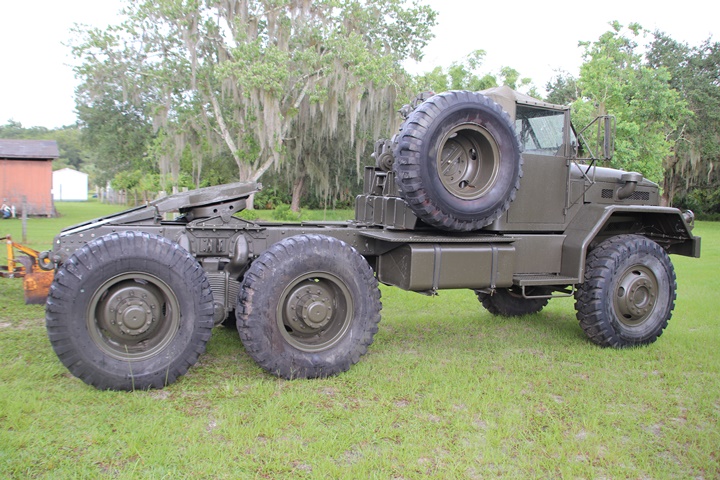
Author's photo added 12-13-2024.
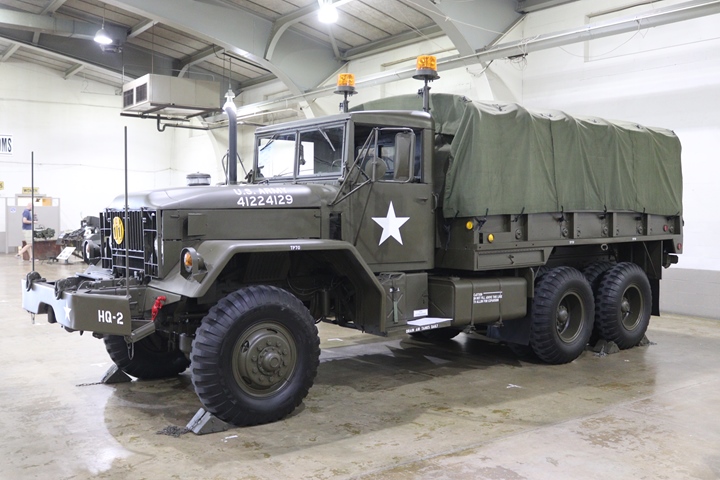
This 1956 Mack-built M54A2 was on display at
the 2019 MVPA Convention in Allentown, PA. There was an
interesting story about this vehicle. The owner entered it as an AM
General because that was the company that did the overhaul on the
vehicle. When the judges checked the serial number on the frame,
it was found to be a Mack. Author's photo added 7-7-2020.
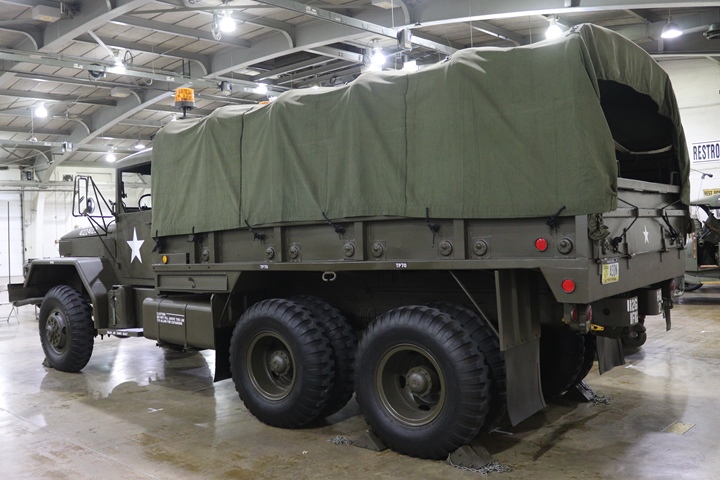
Author's photo added 7-7-2020.
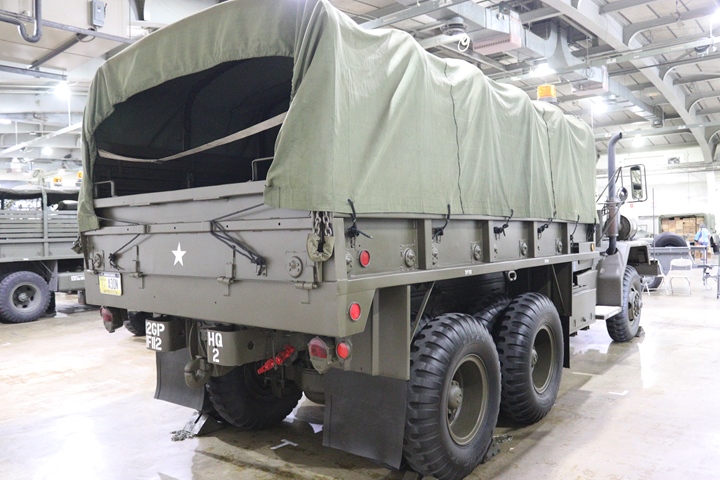
Author's photo added 7-7-2020.
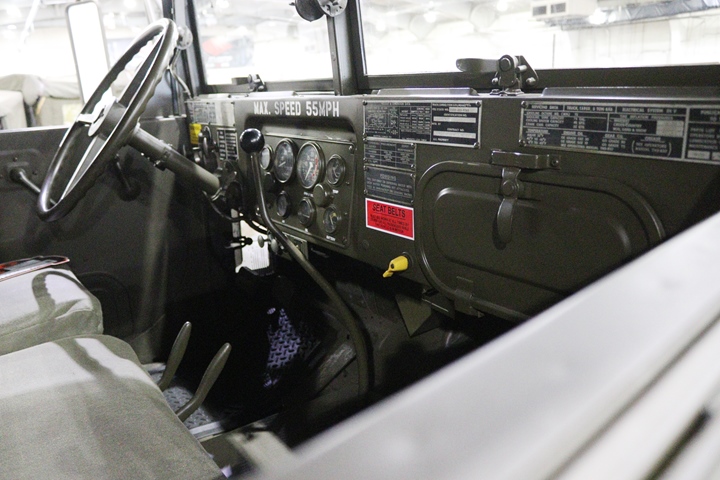
Author's photo added 7-7-2020.
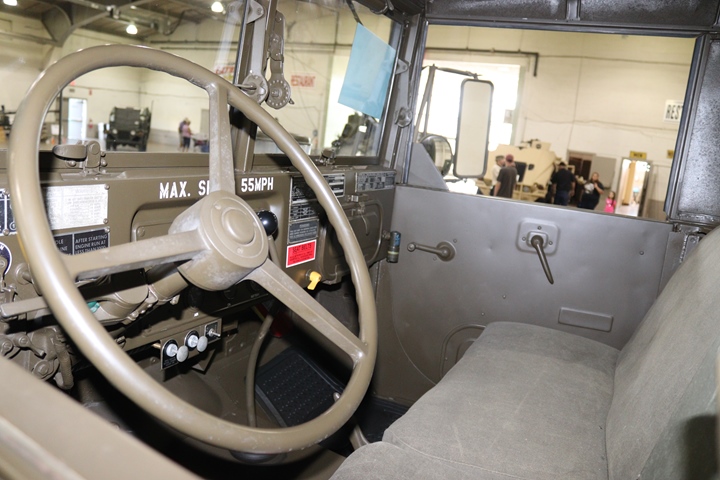
Author's photo added 7-7-2020.
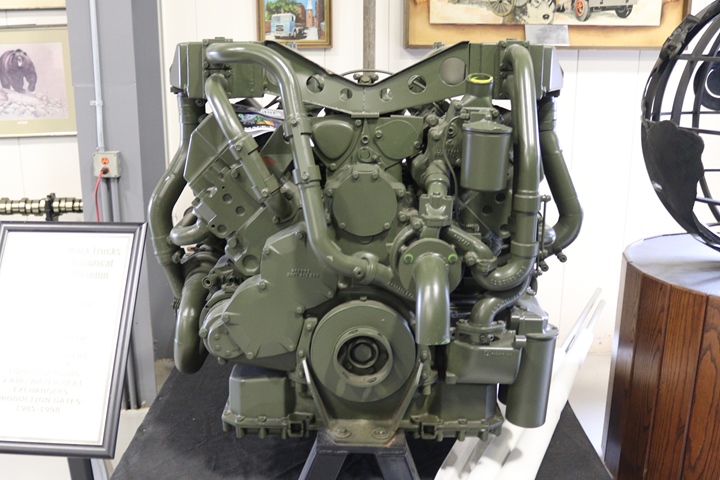
The Mack E-9 military "Hypercharge" V-8
diesel engine was produced from 1985 to 1998. The 998 cu. in.
engine was equipped with four turbo chargers for two stage turbo
charging and also had two air-water heat exchangers. This engine
was on display at the Mack Museum. Author's photo added 7-7-2020.
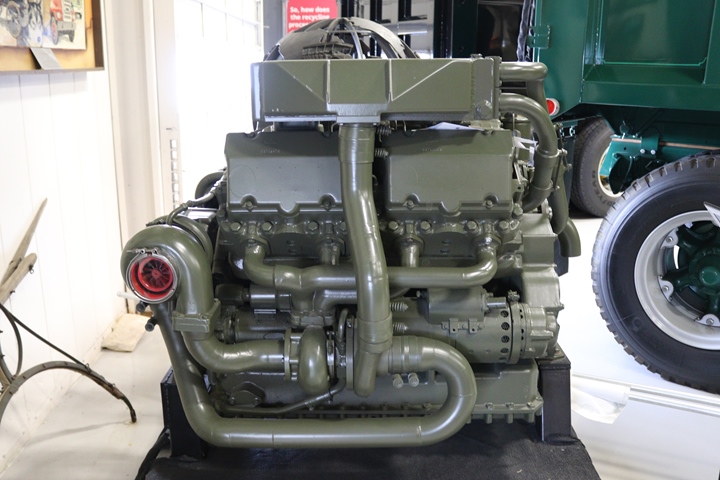
Author's photo added 7-7-2020.
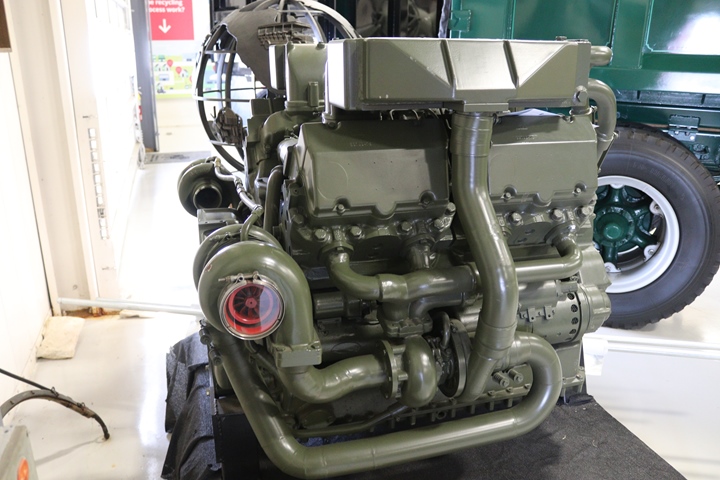
The four turbo chargers can be seen in this
photo. Author's photo added 7-7-2020.
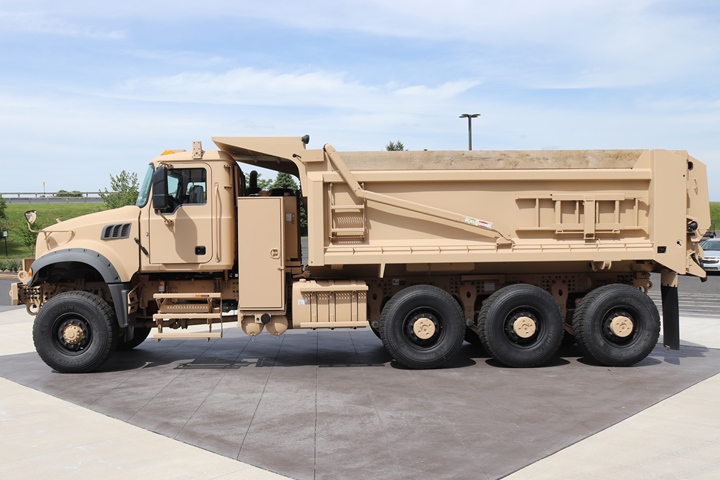
This is one of the first five Mack M917
Heavy Duty Dump trucks delivered to the U.S. Army on June 10,
2019. I took this photo in front of the Mack Customer Center on
June 7, 2019, after visiting the Mack Museum at this location.
Three days later this vehicle, and four others were delivered to U.S.
Army officers in a ceremony inside the building. The M197A3 is
based on Mack's civilian "Granite" heavy duty dump truck.
Author's photo added 7-7-2020.
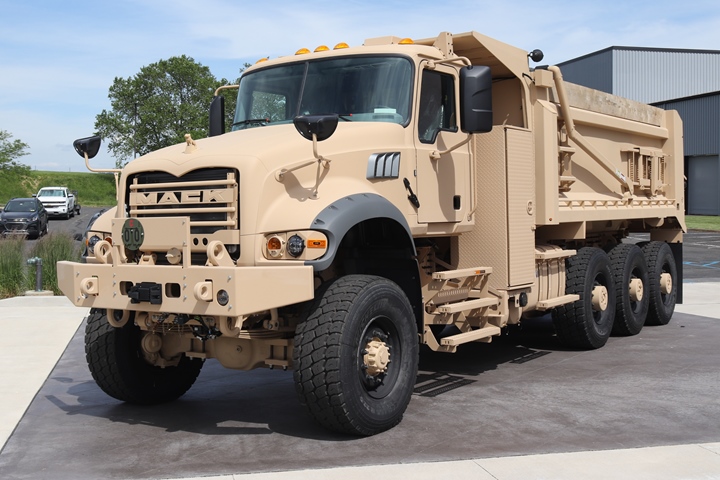
Author's photo added 7-7-2020.
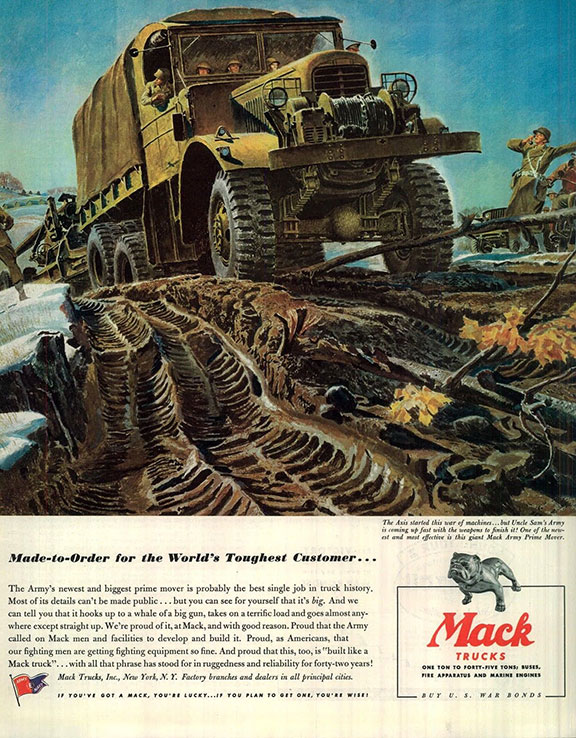
This page opened with photos of the Mack NO
series prime mover trucks for pulling 155mm Long Tom cannon. It
will close with this iconic World War Two era advertisement showing the
same type of truck.
Mack - Geared for Victory
This is a 1942 magazine the company produced for its employees to show
how they were contributing to the winning of World War Two.
This links to an excellent PDF version provided by the Mack Defense
Division of Mack Trucks.
|


















































































































